by Jeffrey Dobek
Photos—the author, except as noted
A filing with the Interstate Commerce Commission on November 16, 1981 signaled the coming end of Conrail freight service on the Clinton Branch between Lenawee Junction and Clinton, Michigan:

Although press reports early in the year had suggested that Conrail’s entire Clinton Secondary Track from Vulcan, Ohio (a junction near Air Line Yard in Toledo) to Clinton, Mich. may be abandoned, the final filing in late 1981 included only the northern end of the line, the 13.7 miles from Lenawee Junction north to Clinton. The filing started a legal process, and if no objections were raised, the line could be abandoned by Conrail four months later (under the ICC rules at the time).
Thus, with the clock ticking, let’s look back at the final months of the Clinton Branch, some 40 years later. These months were difficult ones, as the severe winter of 1981–82 took its toll on operations. Snow, ice and derailments became standard challenges, and would eventually shorten the life of the line even further.
The Customers
The line’s largest customer, the Budd Company Wheel and Brake Division in Clinton, had given up using rail service in 1980. Shortly after that, the regular Clinton-based job (“the Clinton Local”) was cut. From that point onward, only extra trains ran over the line on an as-needed basis.
The only remaining active customers left on the line by late 1981 were located in Clinton. Tri-County Logging, a sawmill, would receive logs loaded in gondolas. The Pallox Company, a producer of wooden shipping pallets, would receive lumber on bulkhead flatcars.
From Clinton, south through Tecumseh, to Lenawee Junction, no other active customers remained. Conrail would run up to Clinton once every week or two with cars for the two customers there.
The Weather
The weather after Christmas 1981 put the region in a deep freeze. For January and February 1982, the average temperature was a bone-chilling 16°F. Snow lay on the ground continuously, and occasional ice storms added to the misery. On the tracks of the Clinton Branch, packed snow, drifts and ice built up, the occasional train service not enough to keep flangeways clear. Shortly after Christmas, the problems began…
Tuesday, December 29, 1981
Late the previous day, a northbound train consisting of Conrail GP-7 #5768 and caboose #19834, was en route to Clinton to collect some empty cars. At the Cummins Street crossing in Tecumseh, packed ice in the flangeways caused the locomotive’s front truck to ride up and derail. The train blocked the street, and unable to rerail it, the crew went off duty.
The next morning, the local railfans camped out to see what would happen. About midday, a Conrail work crew as well as a train crew showed up. A short time later a large Pettibone crane arrived. It was set up on the track, and it carefully lifted the locomotive’s front end back onto the tracks.
Apparently not wanting to risk any further incidents, the short train backed up to the Tecumseh yard, where the locomotive ran around the caboose and then departed south, back to Lenawee Jct. and onward to Toledo.
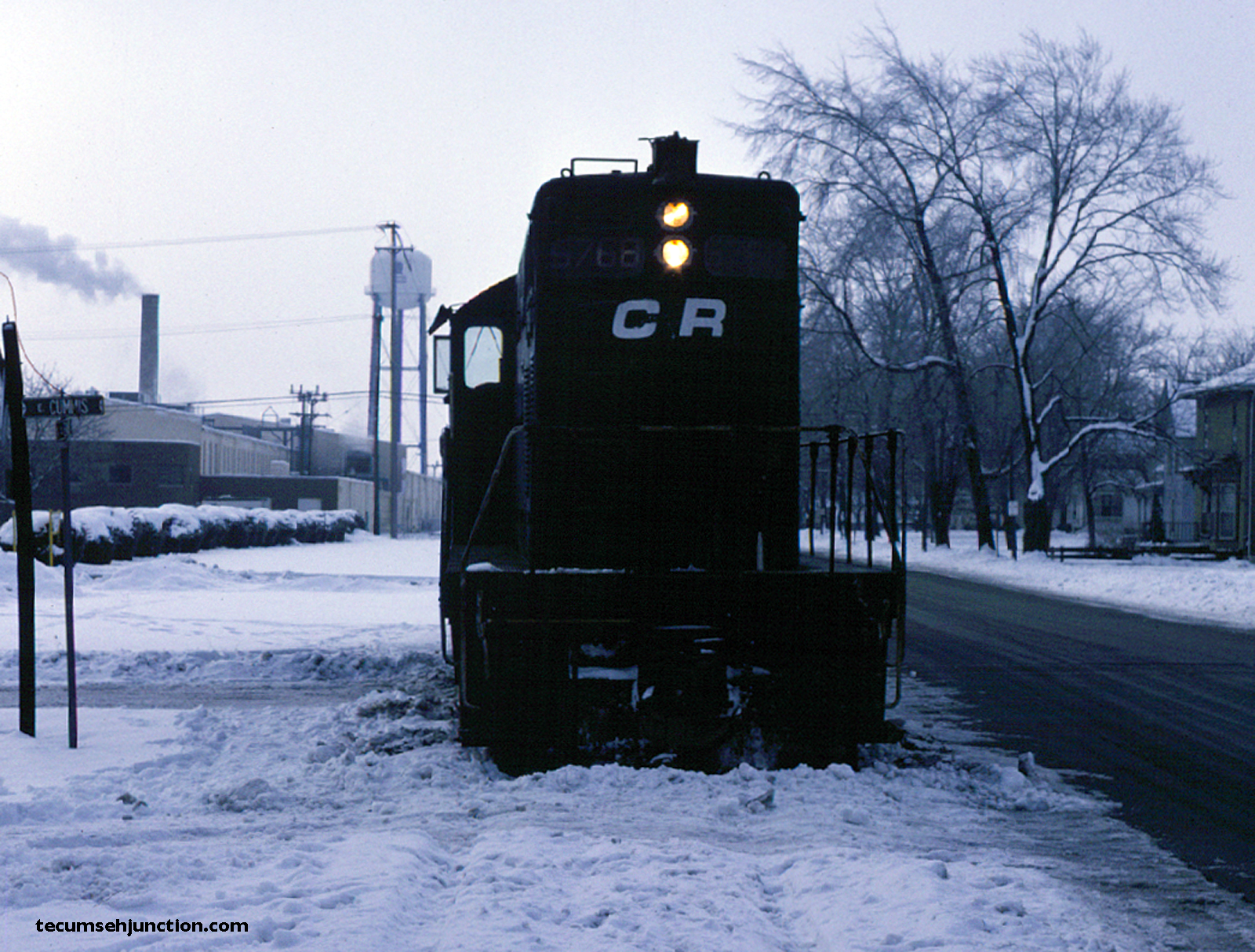
Conrail #5768 rests on the Cummins Street crossing in Tecumseh. The back end of the locomotive is sitting on the diamond crossing of the DT&M spur.
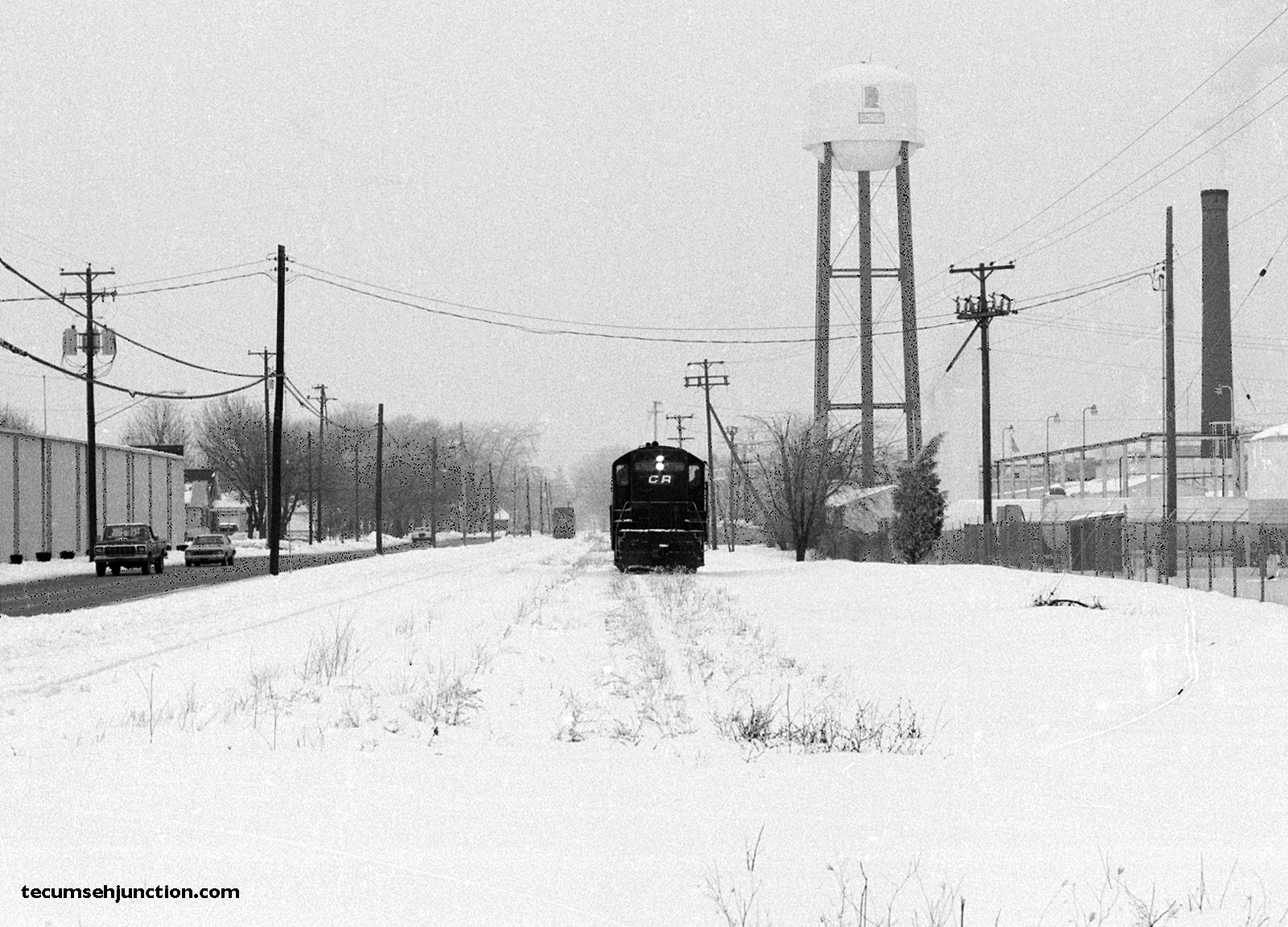
The geep runs around the caboose in the Tecumseh yard, with the Tecumseh Products Company on the right.
Thursday, January 21, 1982
Following the aborted run on December 29, no further trains ran until January 21. With cars remaining to be collected from Clinton, Conrail decided to send a Jordan spreader up the line to clear the accumulated snow. Conrail GP38-2 #8141 and spreader #CR64620 were dispatched from Toledo. The work train entered the Clinton Branch at Lenawee Junction, and worked as far north as the Chase Road (approximately 3 miles), where it derailed on ice and plowed up the ground. The run was abandoned, and after rerailing, the work extra returned to Lenawee Junction. There it did some plowing before returning to Toledo.

The Jordan spreader is dragged backward, still derailed, to reach straight track, where it would be re-railed.
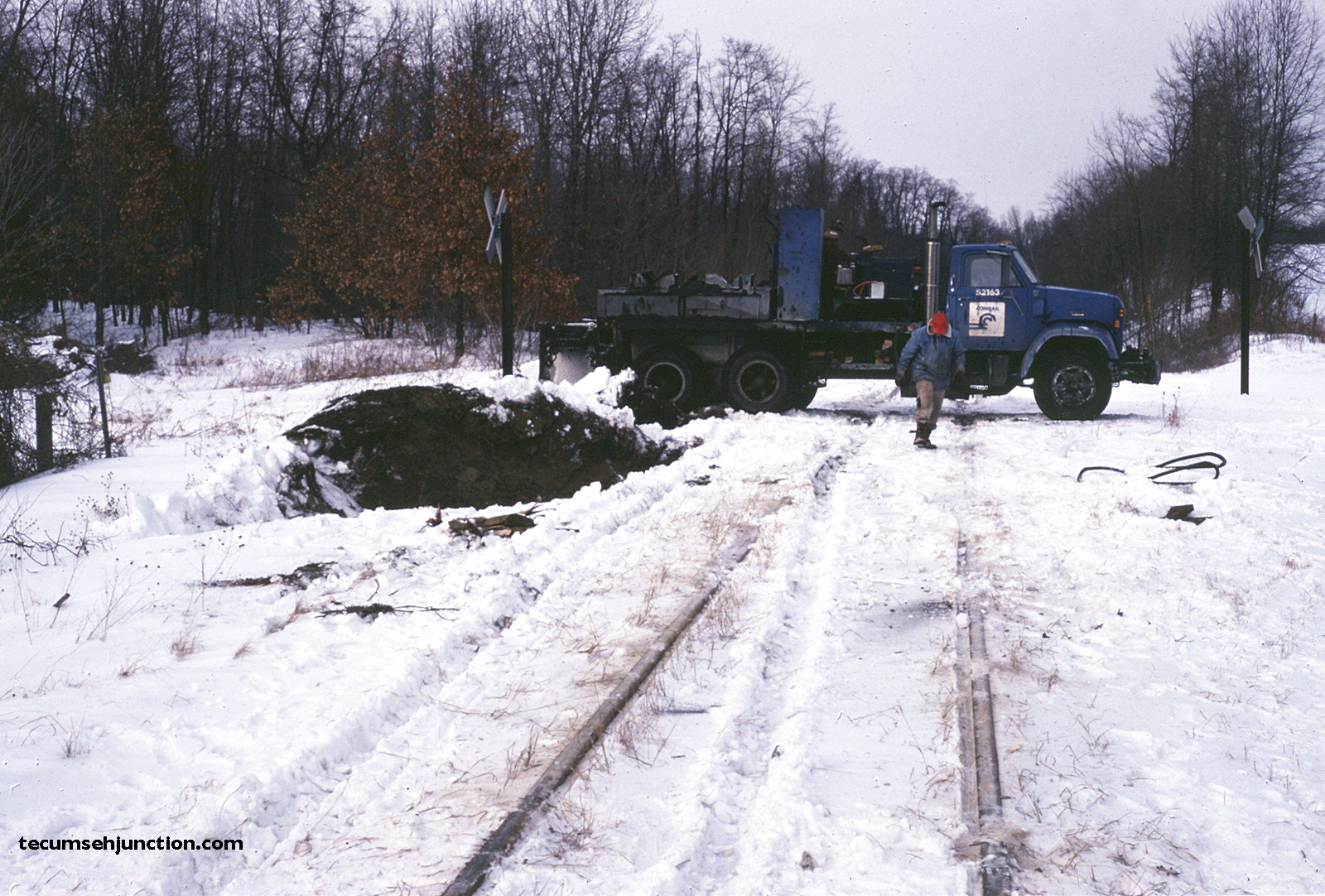
The point of the derailment, just south of the Chase Road crossing. The dirt pile on the left was where the spreader came to a rest. A Conrail workman collects equipment to load back onto the block truck
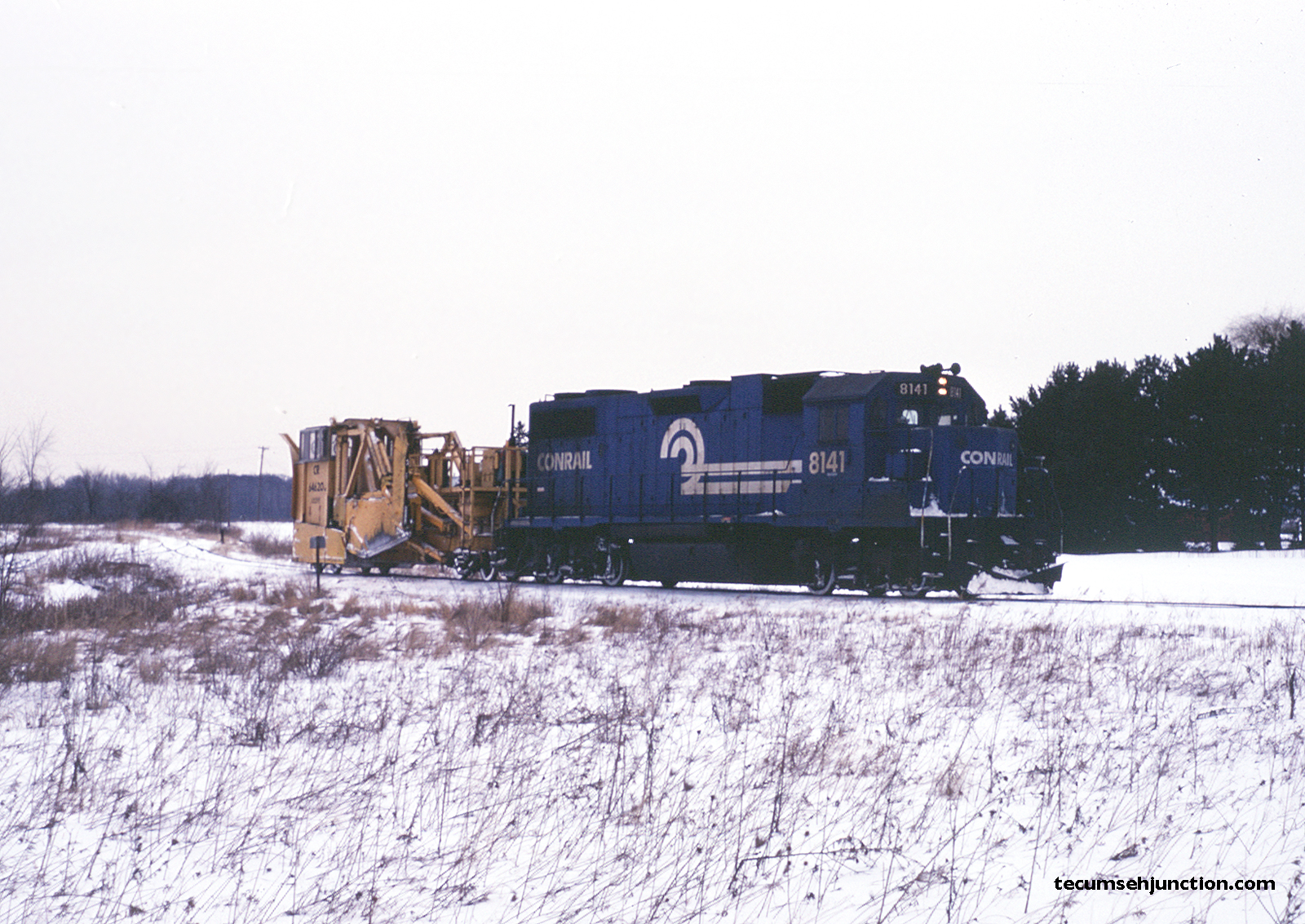
With the Jordan spreader back on the track, #8141 returns to Lenawee Junction. Here it curves around the east wye leg towards Toledo.
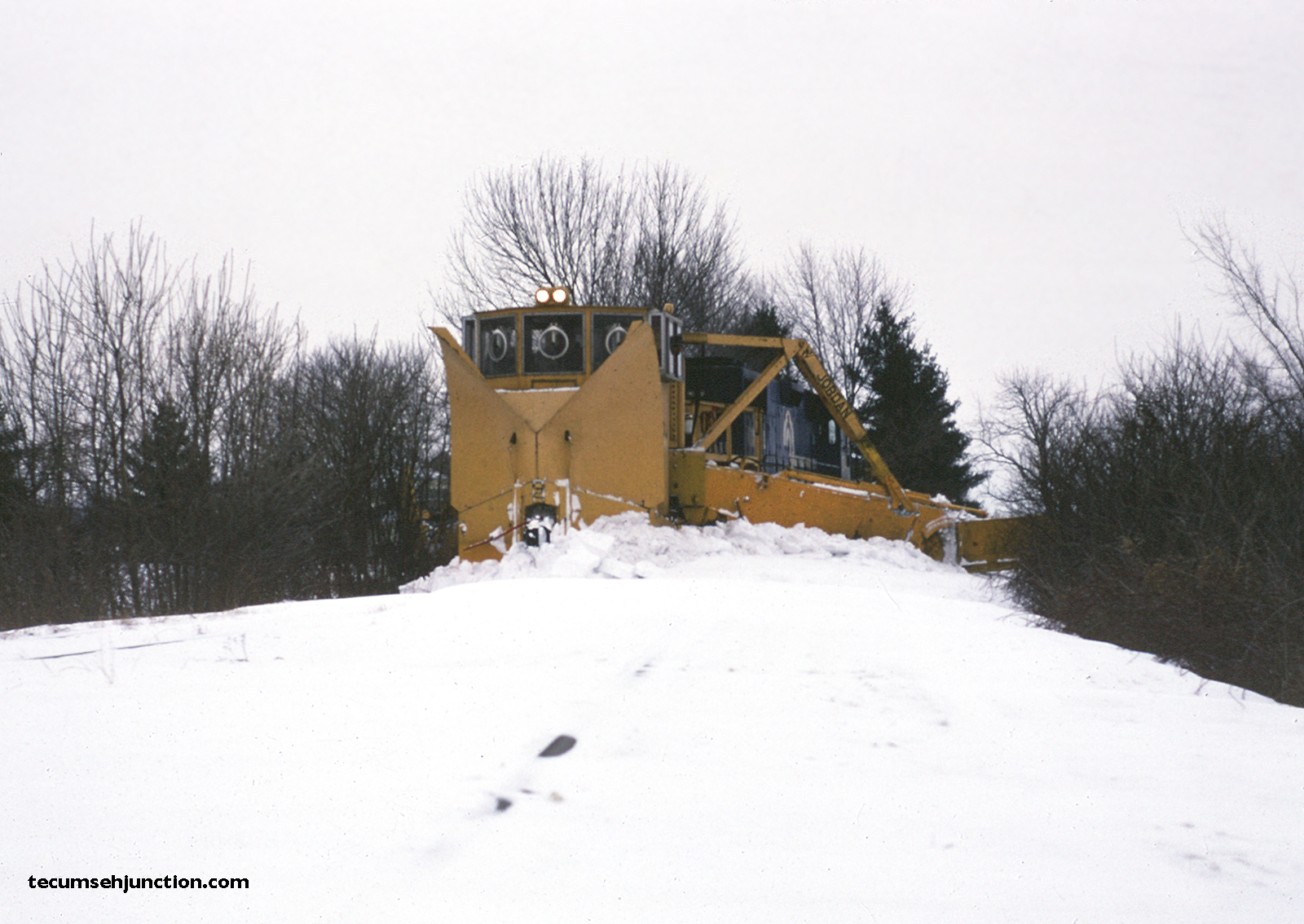
Before departing for Toledo, the spreader plowed the accumulated snow on the east and south legs of the Lenawee Junction wye.
Saturday, January 30, 1982
Following the misadventure the previous week with the Jordan spreader, Conrail gave up and ran a backhoe all the way up the line to Clinton, clearing snow and crossings.
Task accomplished, a freight was sent out again on January 30, led by Conrail GP-7 #5995, still in Erie-Lackawanna Railroad colors. This time there were also some freight loads destined for Clinton.
The train made it about 5 miles up the line from Lenawee Junction. However, south of Tecumseh, on the rising grade near the intersection of Raisin Center Highway and Gady Road, the train either got stuck in snow or lost traction. Unable to make any further progress up the grade, a decision was made to back down to Lenawee Junction. I caught up with the train as it was backing across the Norfolk & Western Railway crossing at Raisin Center.
At Lenawee Junction, the cars for Clinton were set out on the west leg of the wye (for later furtherance to Clinton), and the train returned to Toledo with interchange cars picked up from the Lenawee County Railroad.
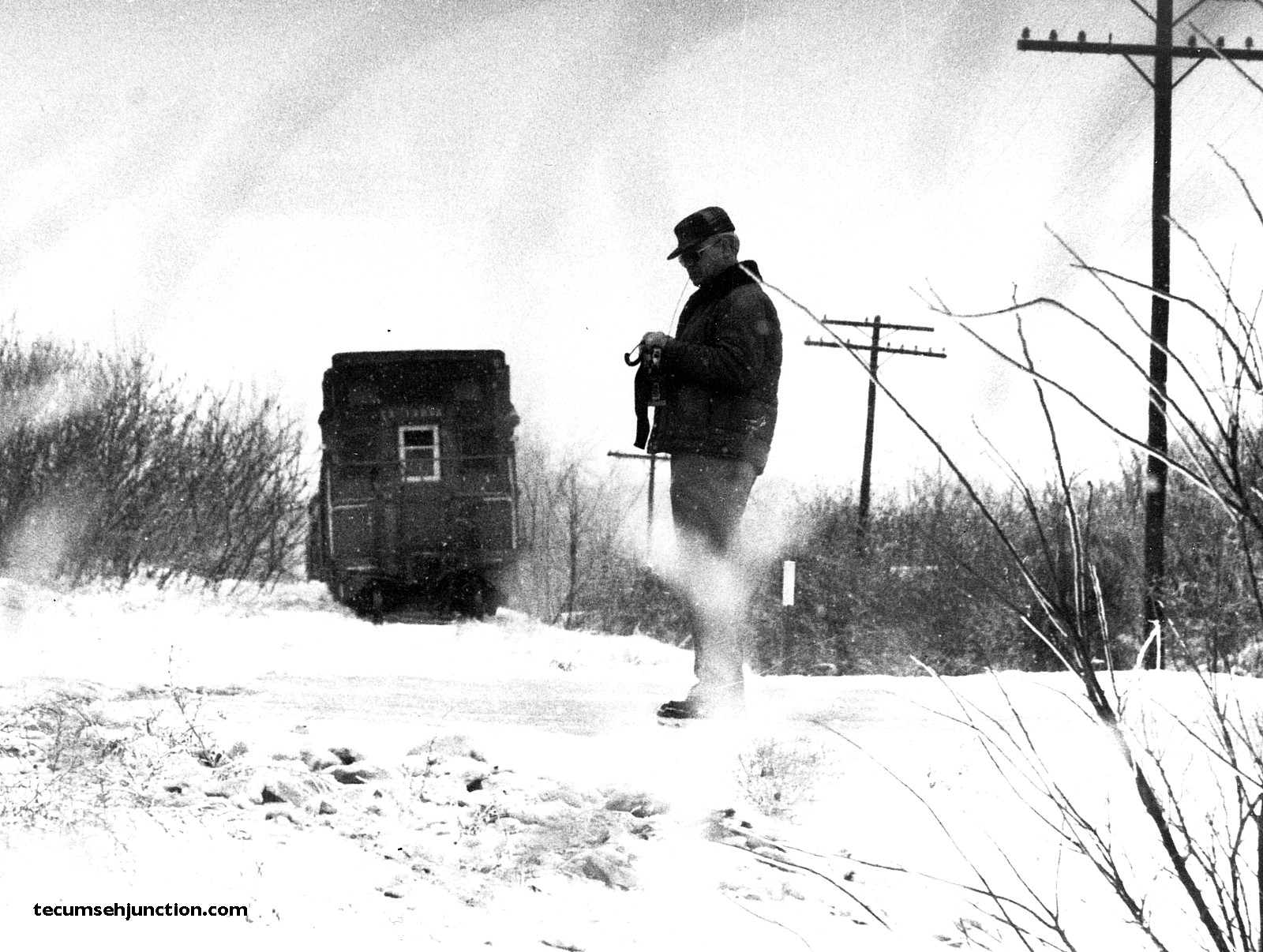
The southbound train waits to cross Raisin Center Highway and the N&W diamonds at Raisin Center. The automatic interlocking system was not working, and the manual override timer had to be used.
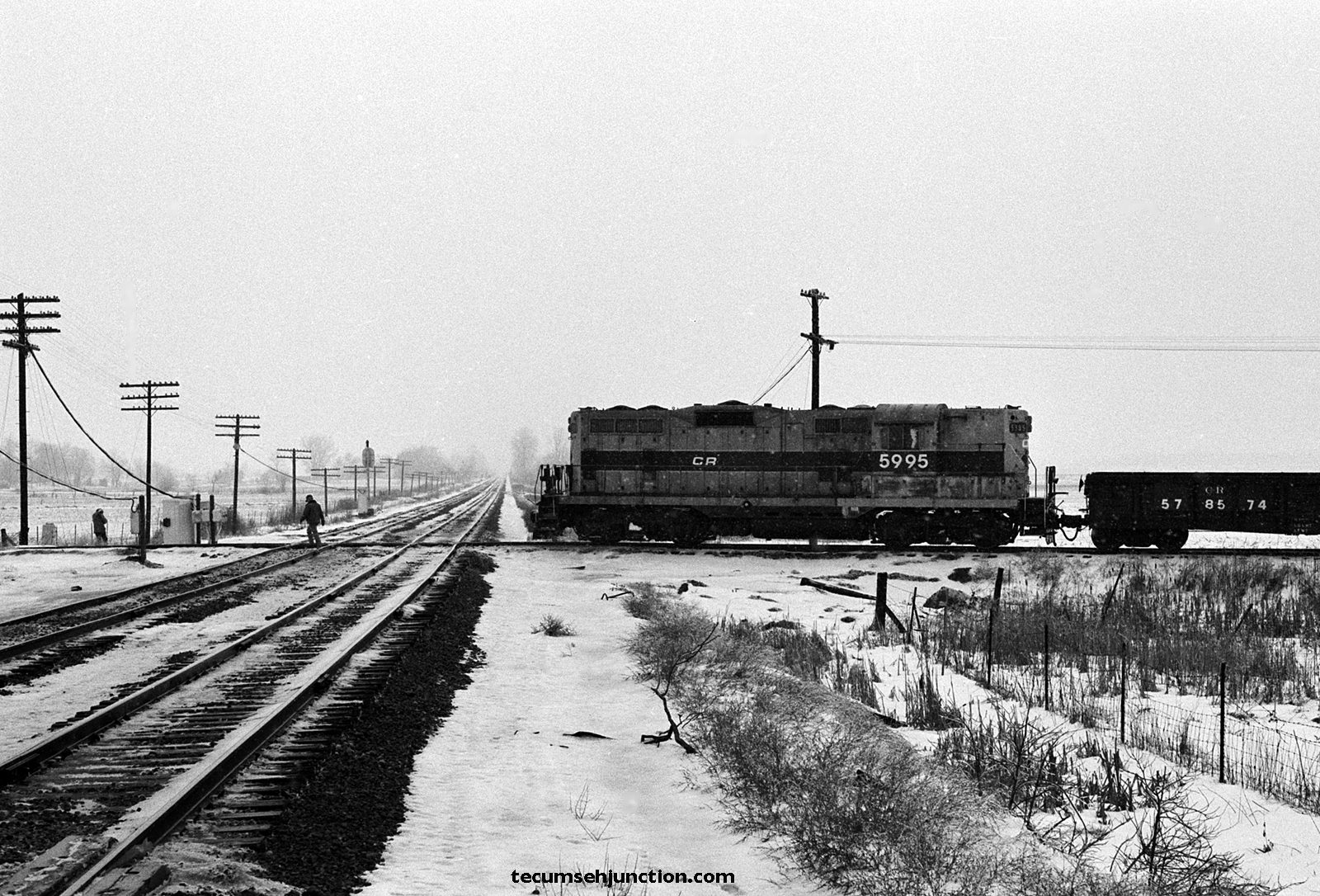
The train has backed across the Norfolk & Western Railway’s ex-Wabash main line at Raisin Center. A crewman returns to close the control box.
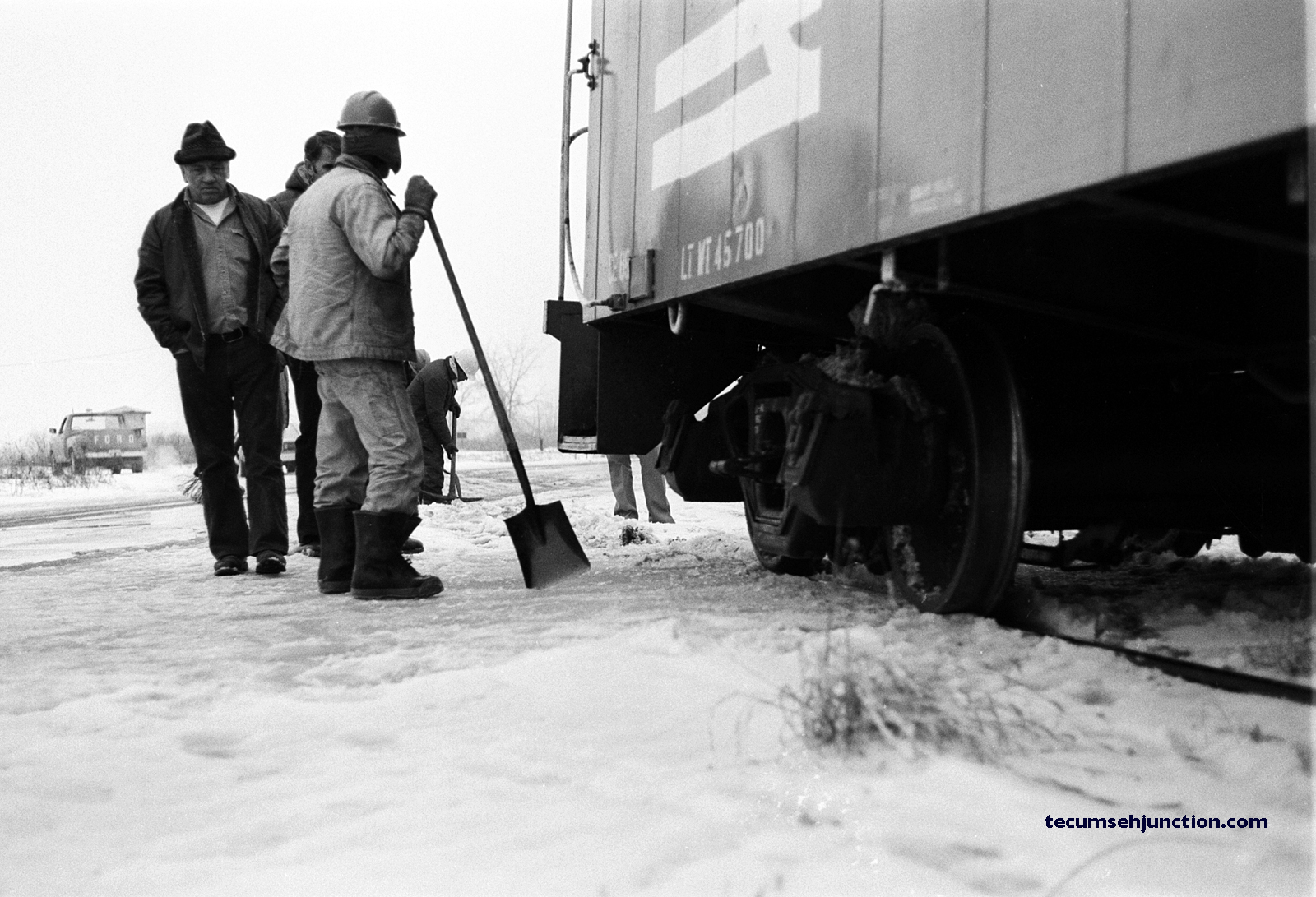
Conrail maintenance-of-way workers carefully observe as the as the caboose is backed over the Deerfield Road crossing, on the west leg of the wye at Lenawee Junction. They were not about to risk another derailment on the ice-packed flangeways.
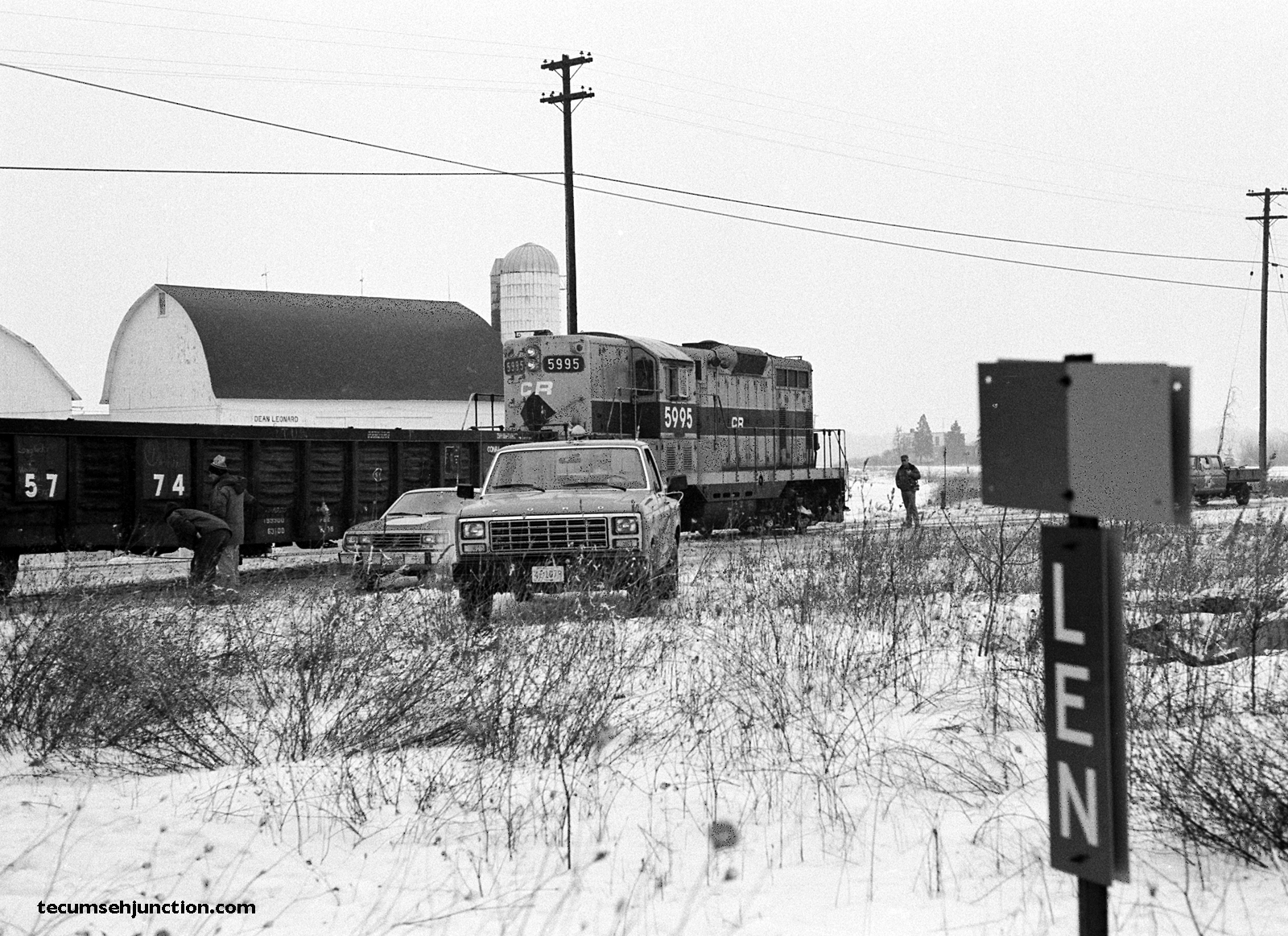
With the Lenawee Junction “LEN” block sign in the foreground, the train continues slowly backing across Deerfield Road. The caboose would be cut off at LCRC end of the wye, and then the locomotive would move forward again to leave the freight cars for Clinton on the west wye track. It then ran down the east wye track and back up the “Old Road” leg of the wye to pick up interchange cars from the Lenawee County Railroad and the caboose before heading for Toledo.
Friday, February 26, 1982
Several weeks passed before another attempt was made to reach Clinton. On this Friday afternoon, I discovered Conrail GP-7 #5903 well off the tracks, just south of Tecumseh. A this location there was a small private crossing leading to the Tecumseh Industrial Park. The crossing had iced over, and the locomotive slid off the rails and to the right.
The locomotive was by itself. Driving south along Raisin Center Highway, I discovered the rest of the train near Gady Road, near the top of the grade up from Sutton Road. Apparently it had been left there so that the locomotive could run ahead and clear the track and flangeways, albeit to no avail.
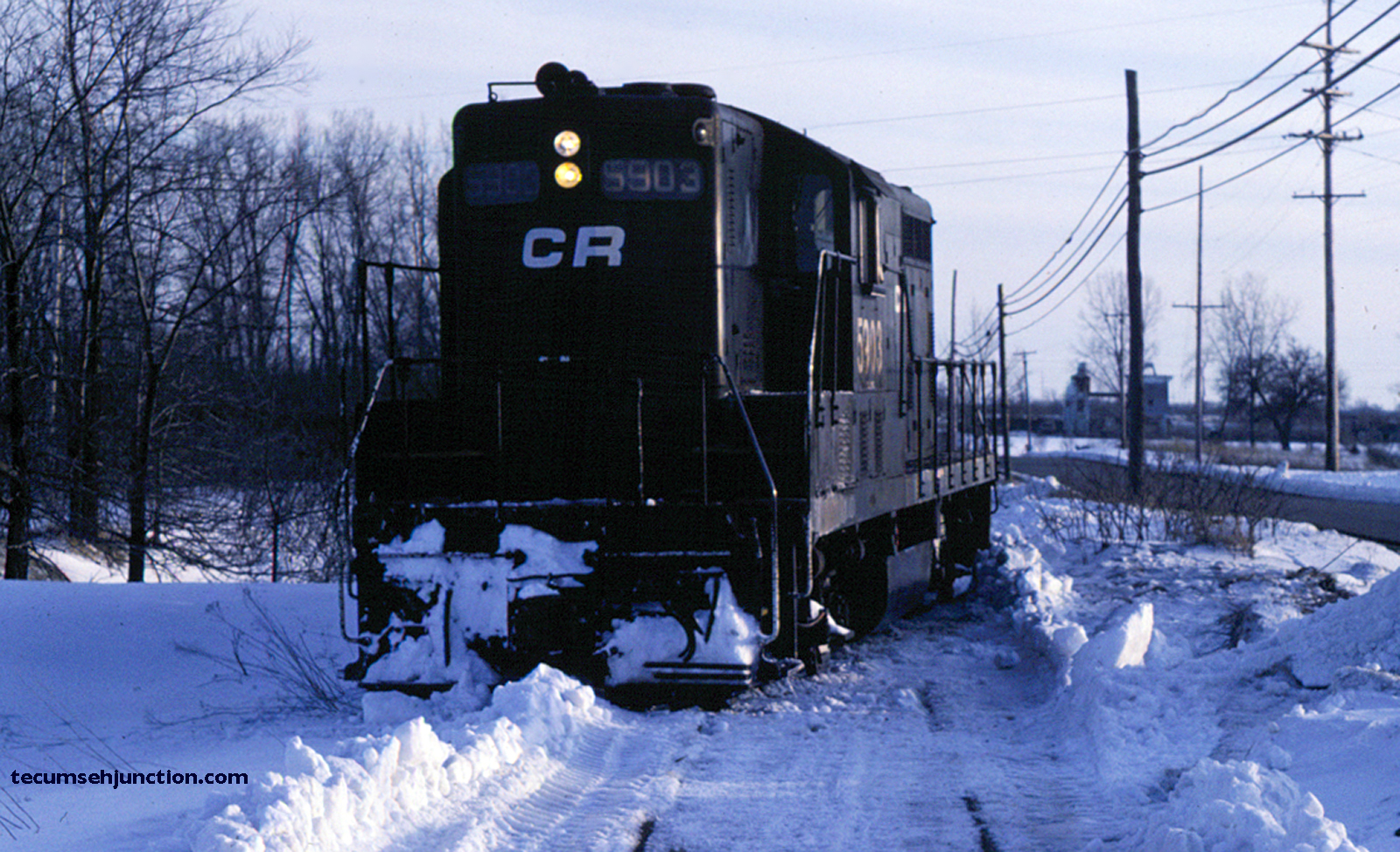
Sitting alone and with no crew, #5903 is off the tracks just south of Russel Road in Tecumseh. The efforts to clear the track with a backhoe are evident, but clearly they were not sufficient.
Saturday, February 27, 1982
The next day a rescue plan was put into action. Conrail SW-9 #8982 was sent up light engine from Toledo. It attached to the cut of freight cars and shoved them north, up to the derailed GP-7. The cars were coupled on, and the switcher was then used to pull the whole train back, as the GP-7 was “walked” back onto the rails. With #5903 back on the tracks, the switcher was left behind and the train continued to Clinton with the freight loads.
Number 5903 returned south to Tecumseh the same day with two empty flatcars from Clinton. The crew ran out of time at Tecumseh and tied up the train for the rest of the weekend.
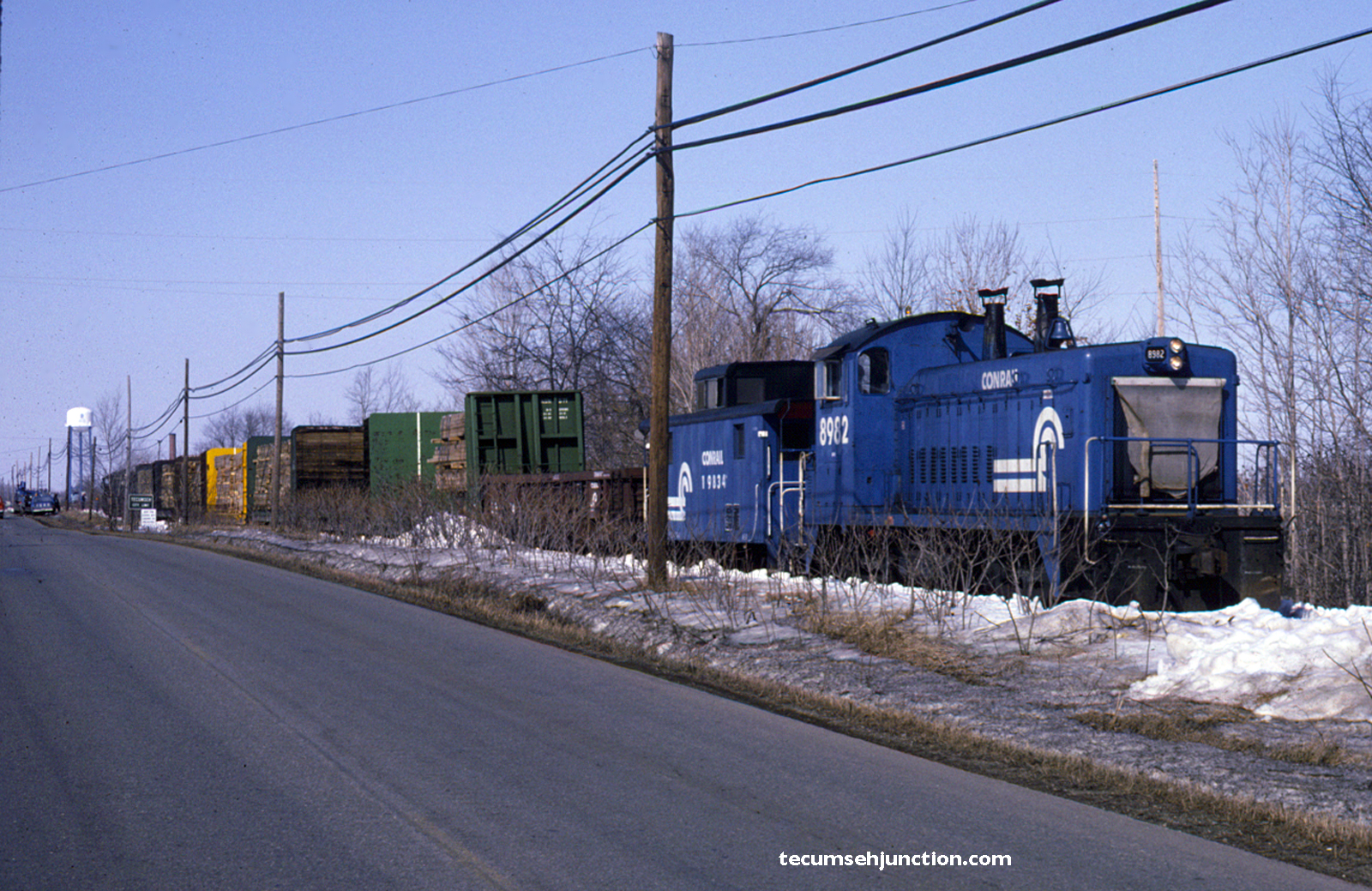
Conrail SW-9 #8982 on the back of the train, having shoved the cut of cars north to the derailment site.
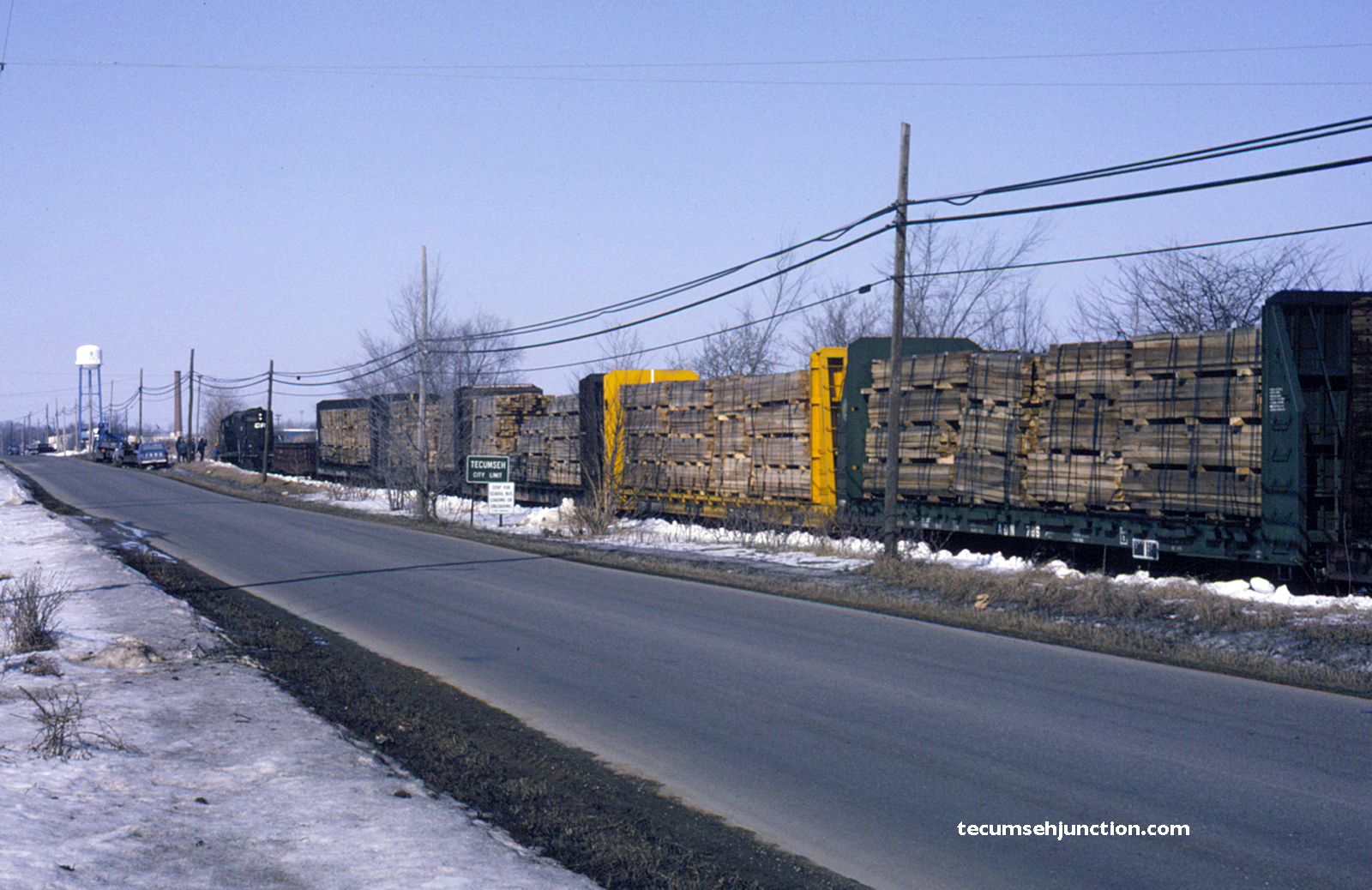
The derailment happened right at the Tecumseh city limits; the Tecumseh Products Company water tower is visible in the distance. This day’s train had five flatcars of lumber for Pallox, and two gondolas of logs for Tri-County Logging.
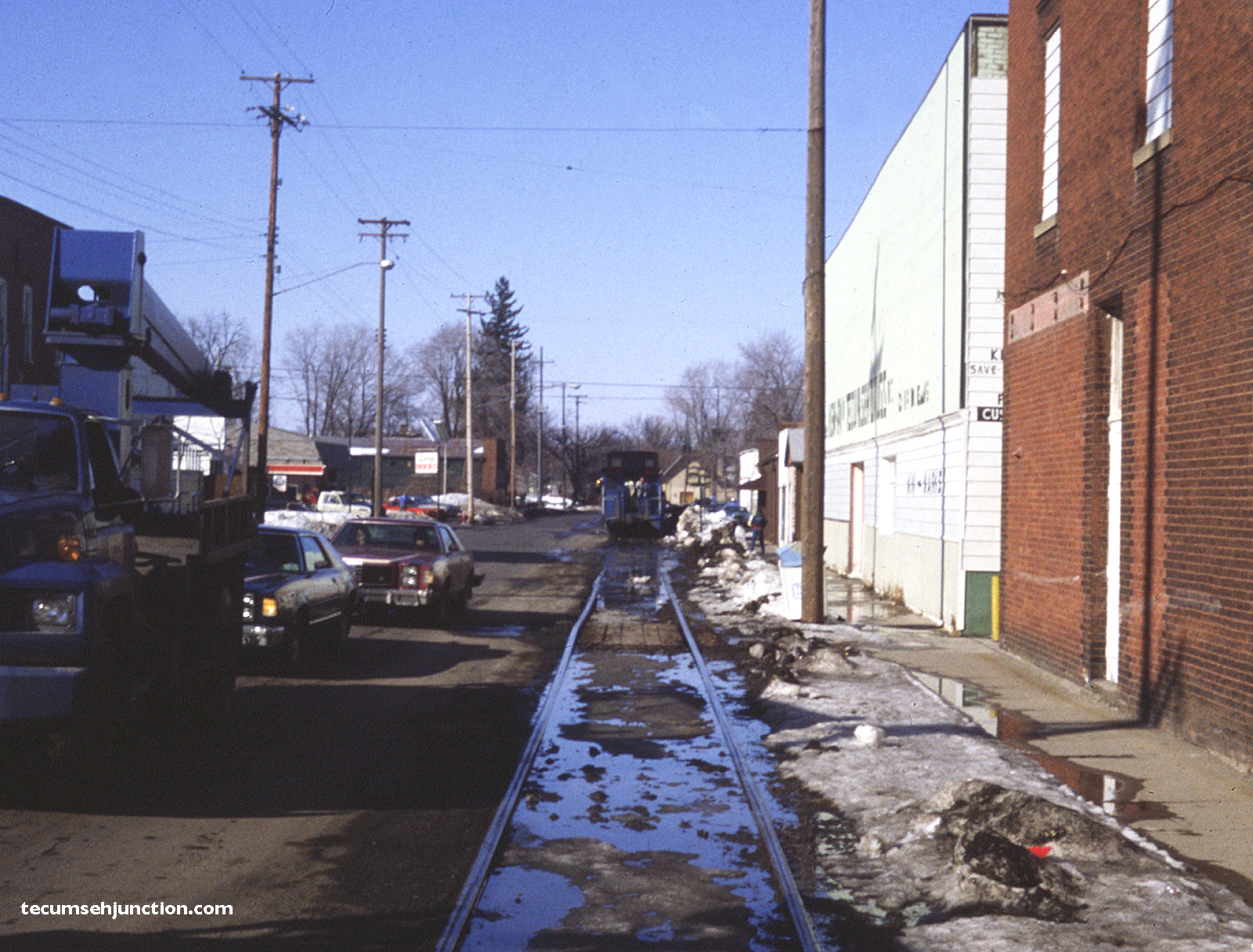
This day was warmer, and some ice was melting. The state of the tracks in downtown Tecumseh shows the poor condition of the line.
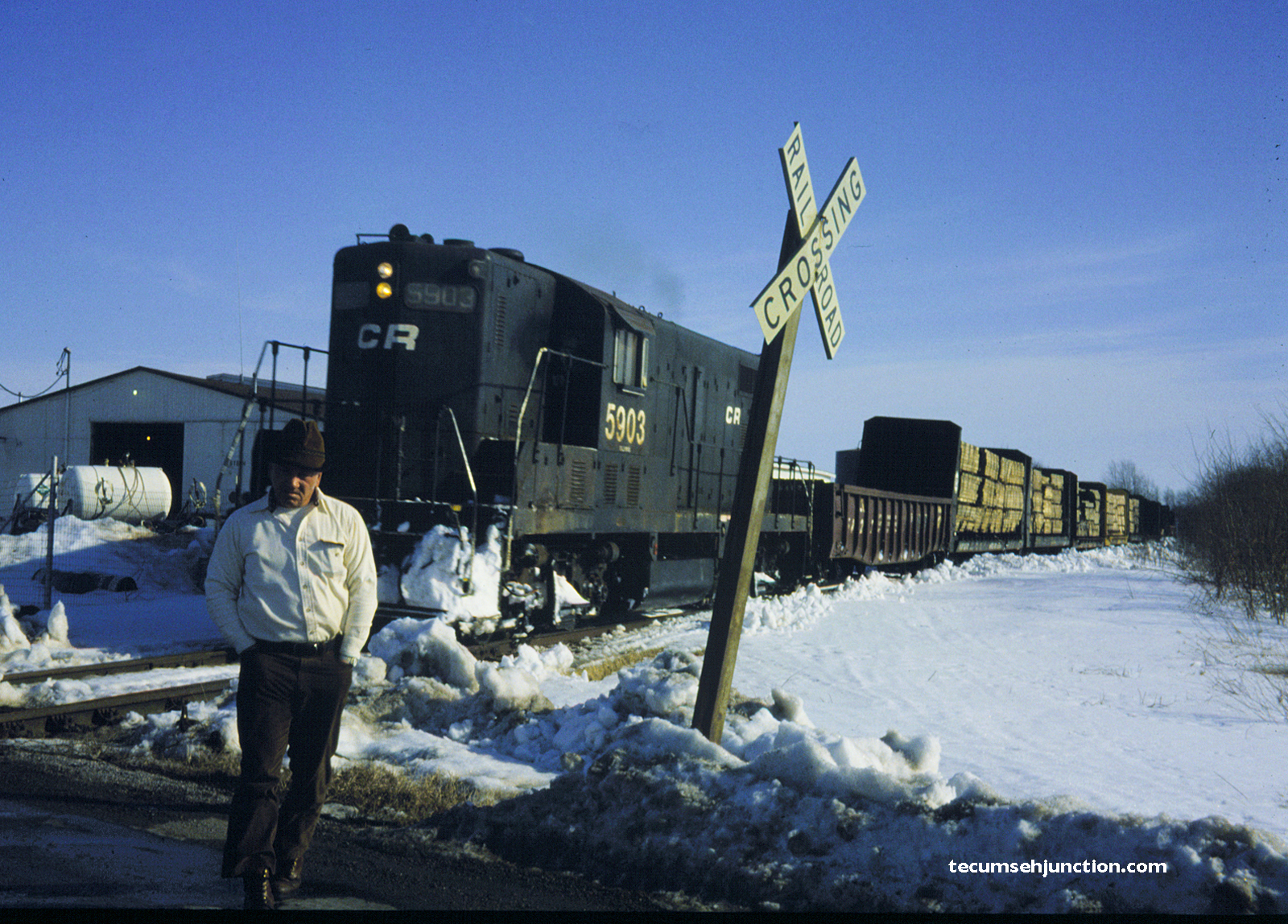
The Conrail maintenance-of-way foreman has inspected the crossing at Staib Road, between Tecumseh and Clinton, and #5903 has received the all clear to proceed.
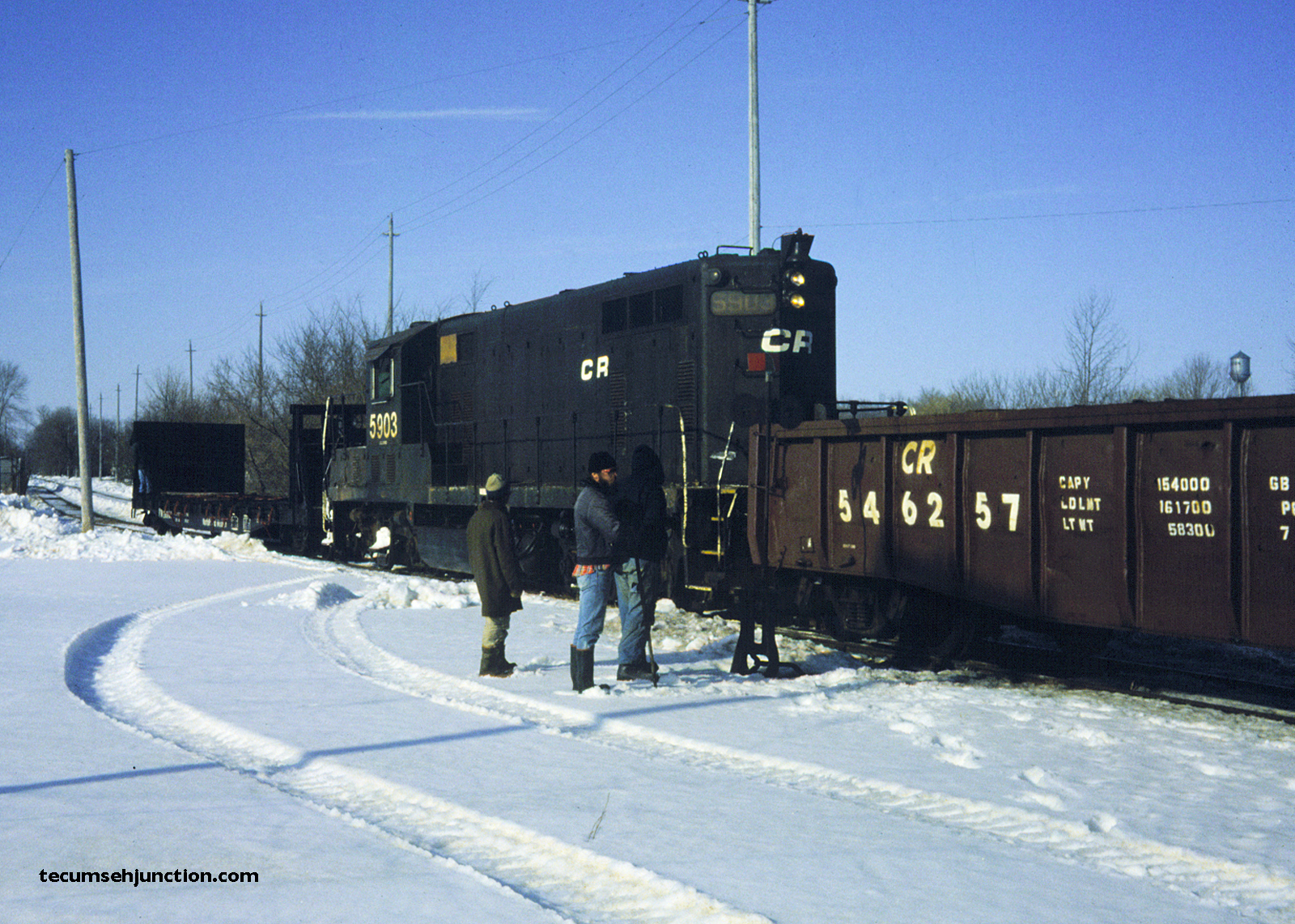
Having reached Clinton, #5903 is doing some switching with an empty flatcar from Pallox and a loaded gondola for Tri-County Logging.
Monday, March 1, 1982
A new crew was called in the afternoon to take the train back to Toledo. Upon reaching switcher #8982, the two locomotives were coupled together, and with the switcher leading, they continued south back to Toledo.
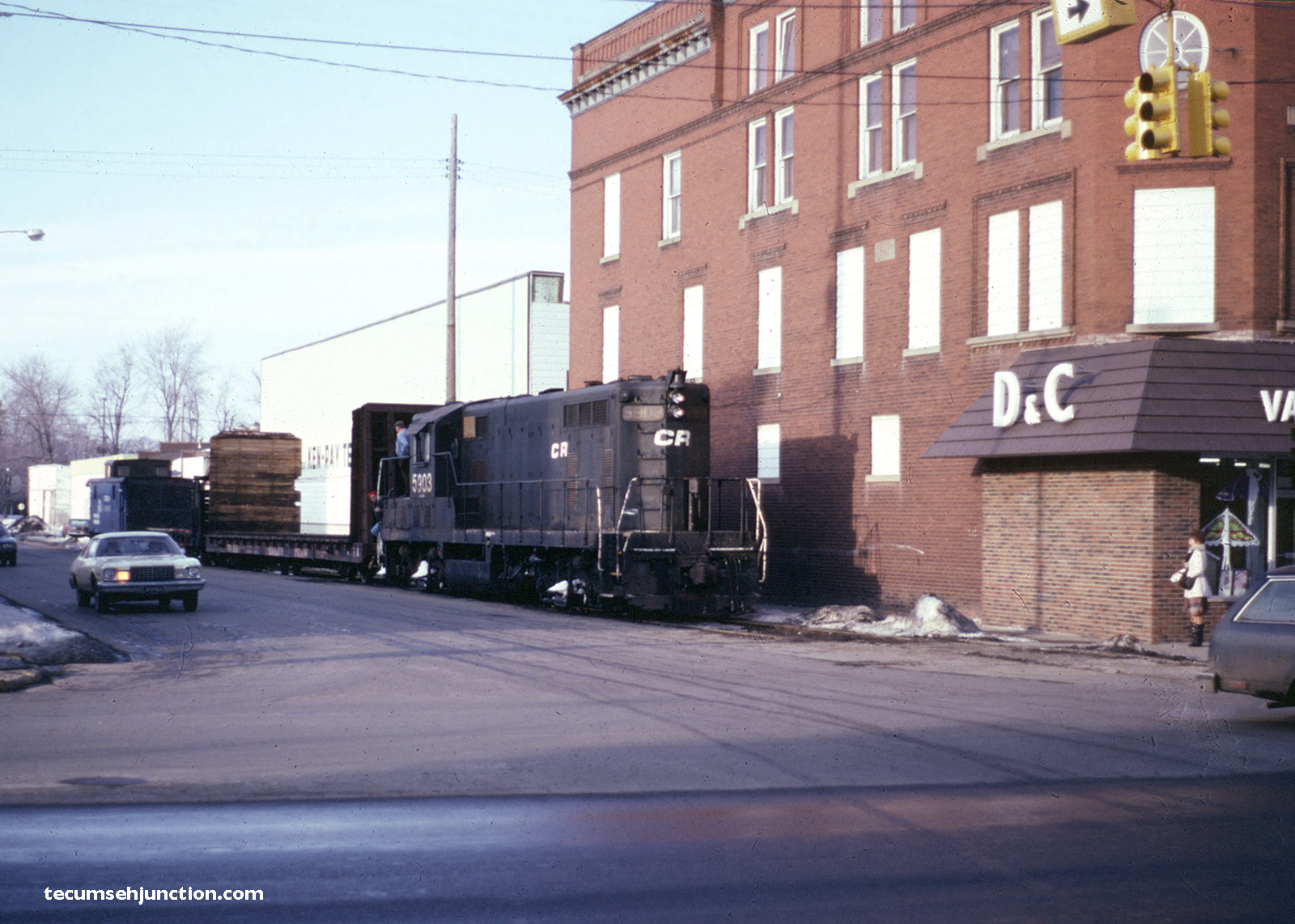
Conrail #5903 has arrived back in Tecumseh, Michigan. Here it was parked while the crew went for dinner.
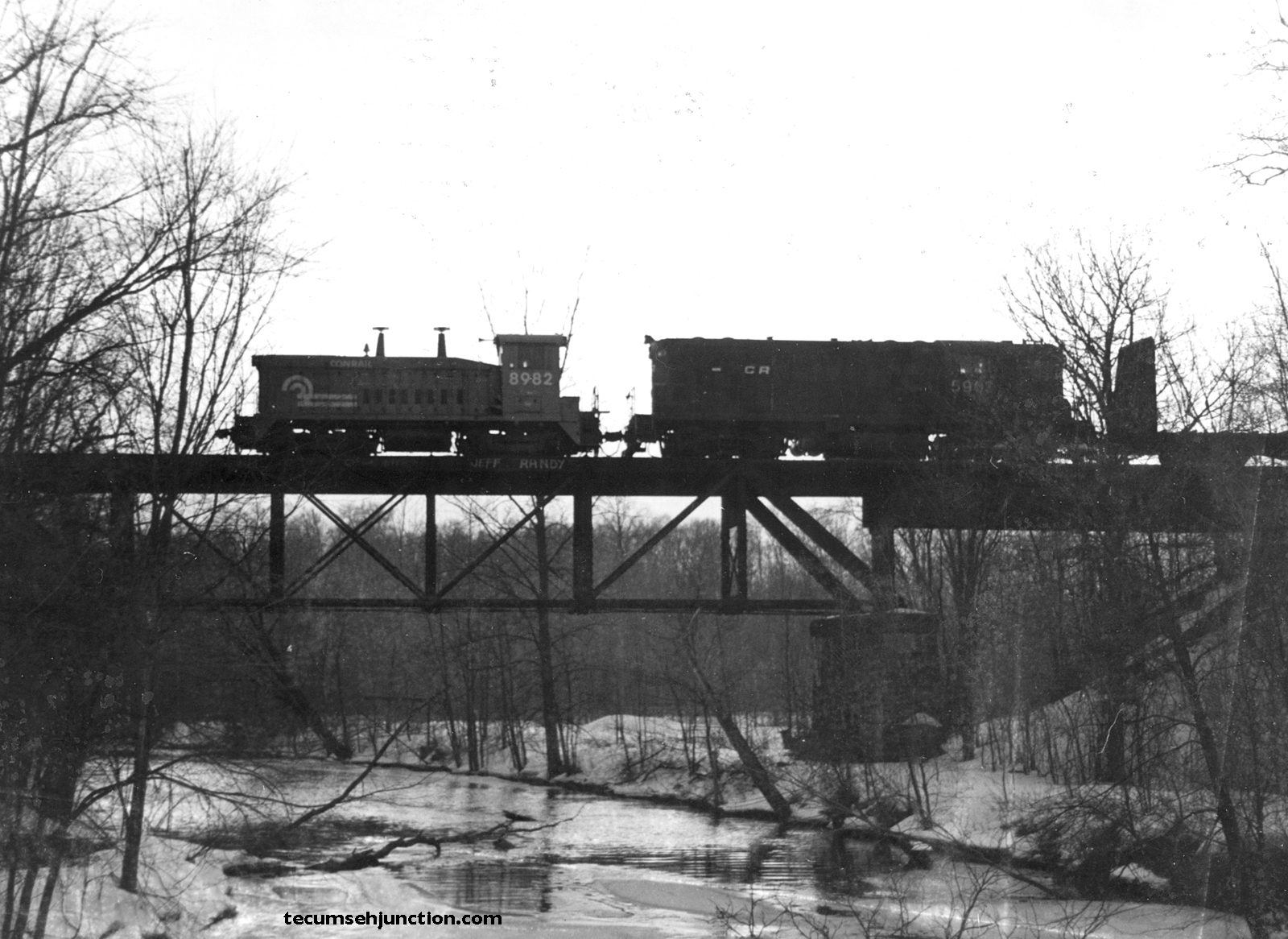
With switcher #8982 now attached to the front of the train, a double-header crosses the River Raisin bridge south of Sutton Road. (Gerald Grossman photo)
Thursday, March 11, 1982
Even though the 4-month abandonment period has yet to end, Conrail has had enough. They have placed an embargo on the Clinton Branch, meaning that no freight traffic would be accepted for customers on the line.
However, seven freight cars remained at Clinton, so a “clean-up” run had to be made. Conrail #5903 and caboose #19834 returned to Clinton on this date to pick up the cars. In a repeat of the recent pattern, the train derailed on iced-over tracks in front of the Ken-Ray drug store in downtown Tecumseh. A block truck was shadowing the train, and help was quickly on hand to re-rail it. The crew then continued north to Clinton, and picked up the empties.
The train returned south to Lenawee Junction the same afternoon, and my notes say it departed Tecumseh at 5:10 p.m. I didn’t have my camera with me that day, but my friend Brad Barritt did manage to capture the derailment earlier in the day.
Conrail’s operations on the Clinton Branch had ended.
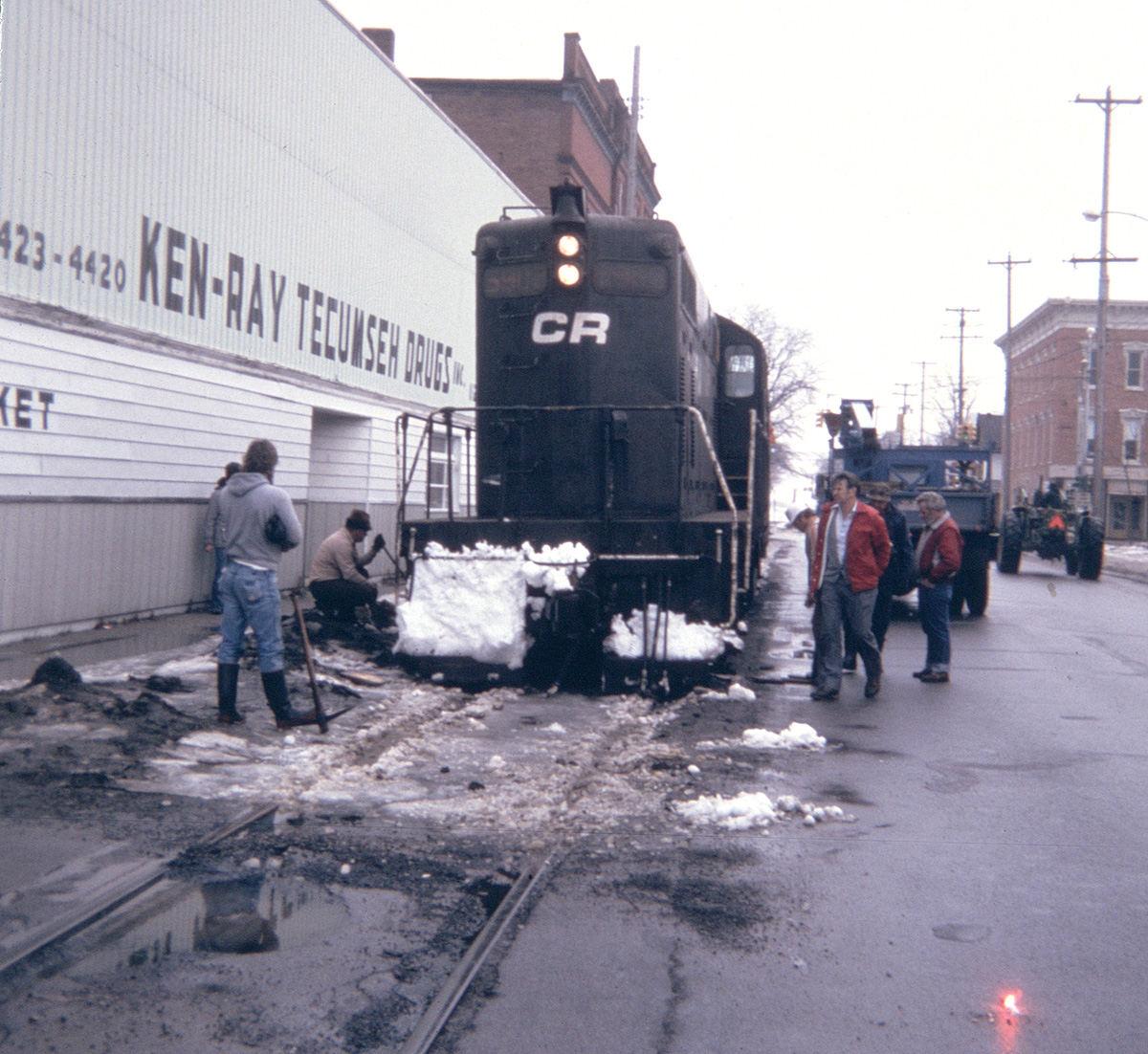
Conrail #5903 lost its fight with the ice in front of Ken-Ray Drugs in downtown Tecumseh. Here the track crew works to re-rail it. (Brad Barritt photo)

Taking no chances, a lookout is posted on the front pilot of #5903 as it continues northward, crossing Brown Street in Tecumseh. This is the last photo taken of a Conrail train on the line. (Brad Barritt photo)
Postscript
Later in 1982, the Southern Michigan Railroad Society was formed with the goal of purchasing the Clinton Branch and establishing an operating railroad museum on the line. Through these efforts and negotiation with Conrail, the scrapping of the line was delayed and eventually a purchase agreement was signed. The SMRS operates on the line to this day.
Thank you to Phyllis Rickard for assisting in research for this post!
2 Comments
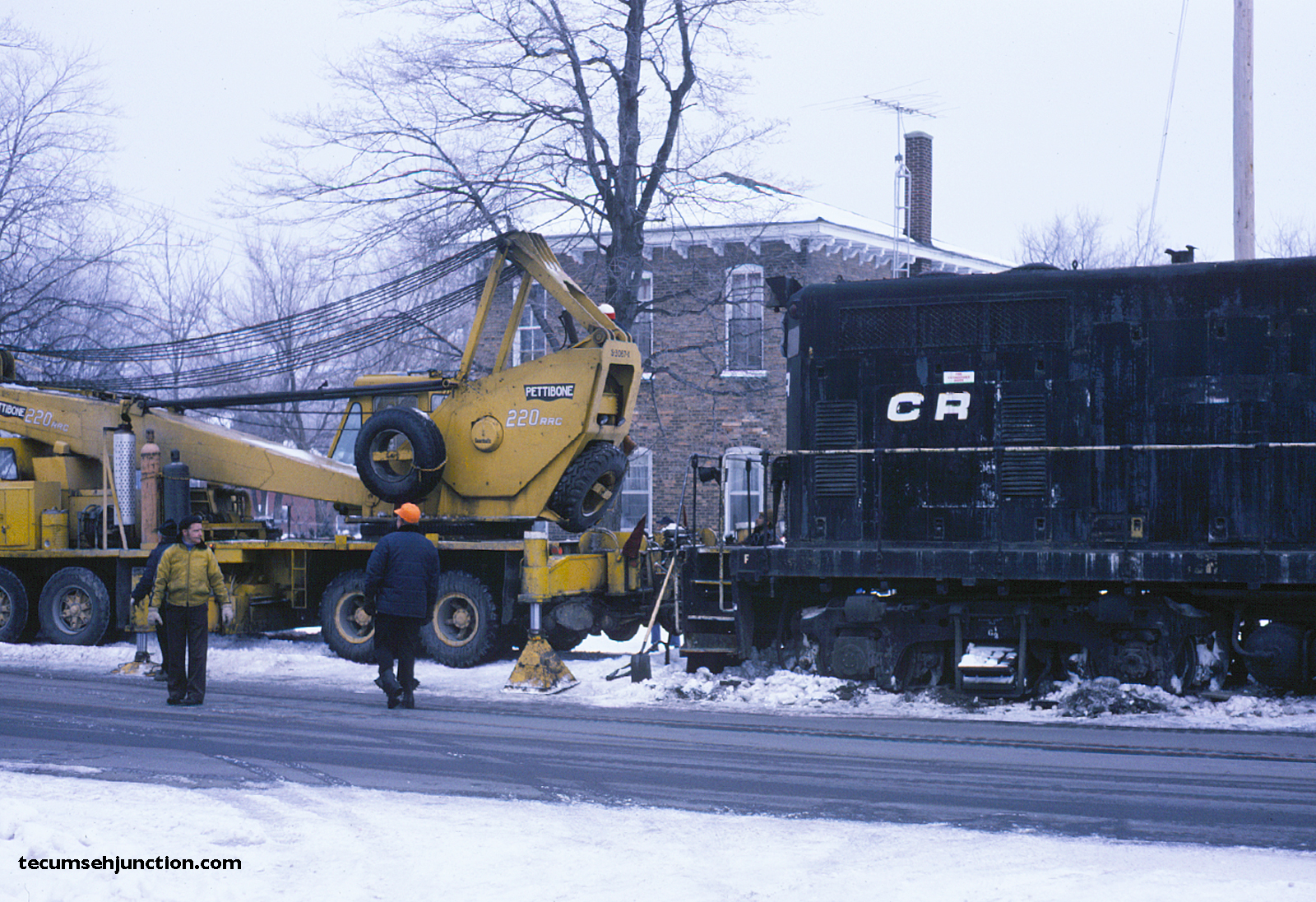
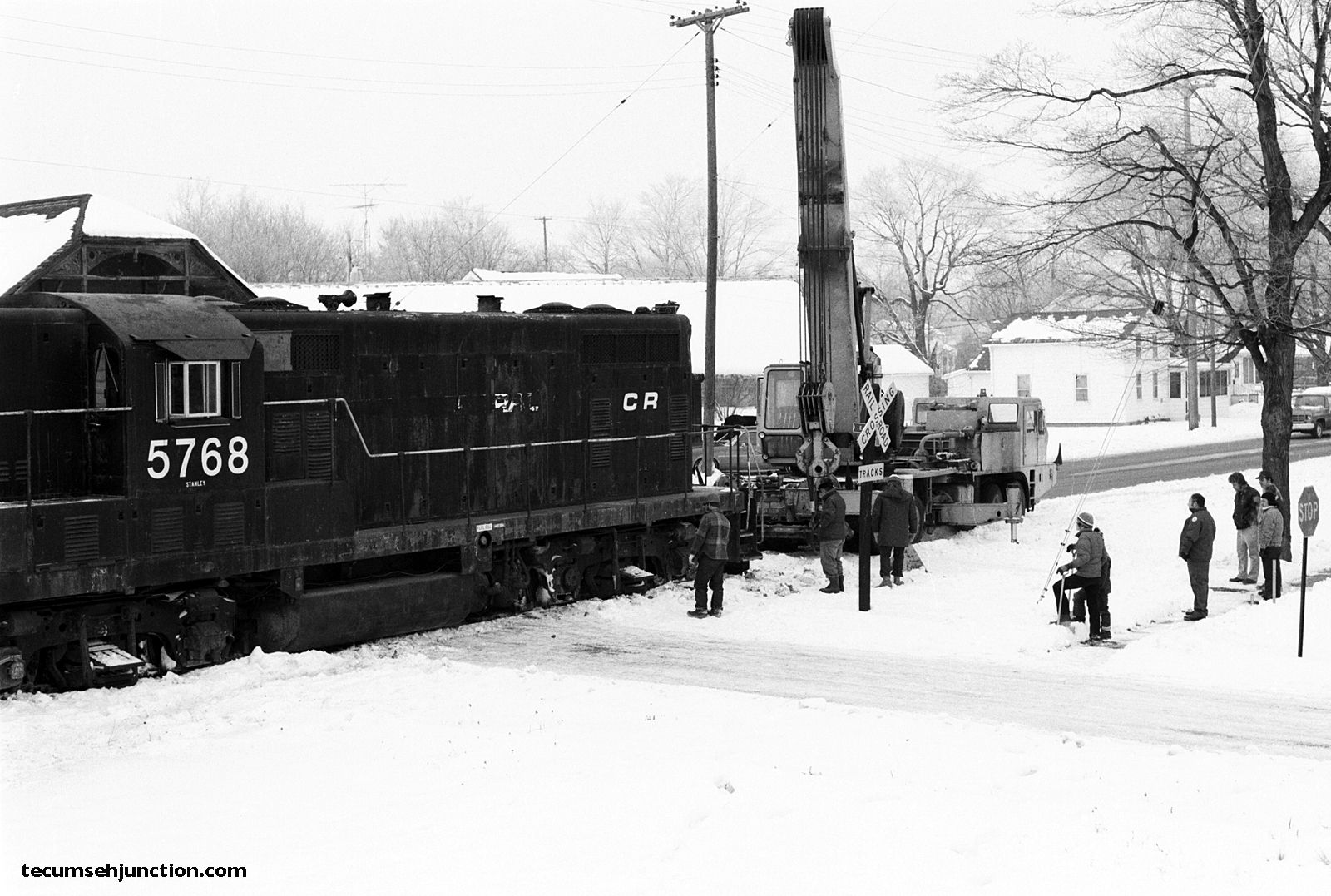
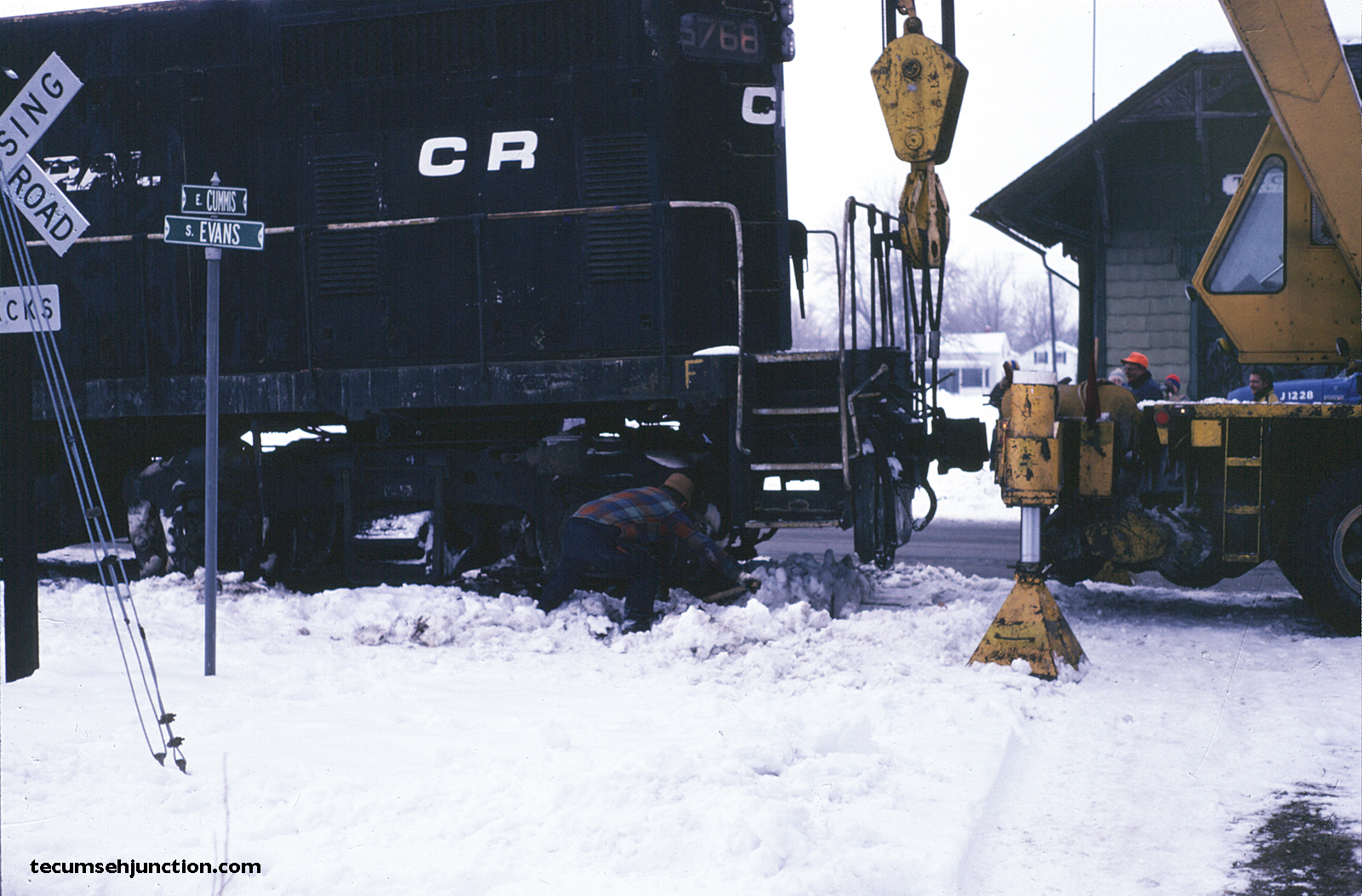
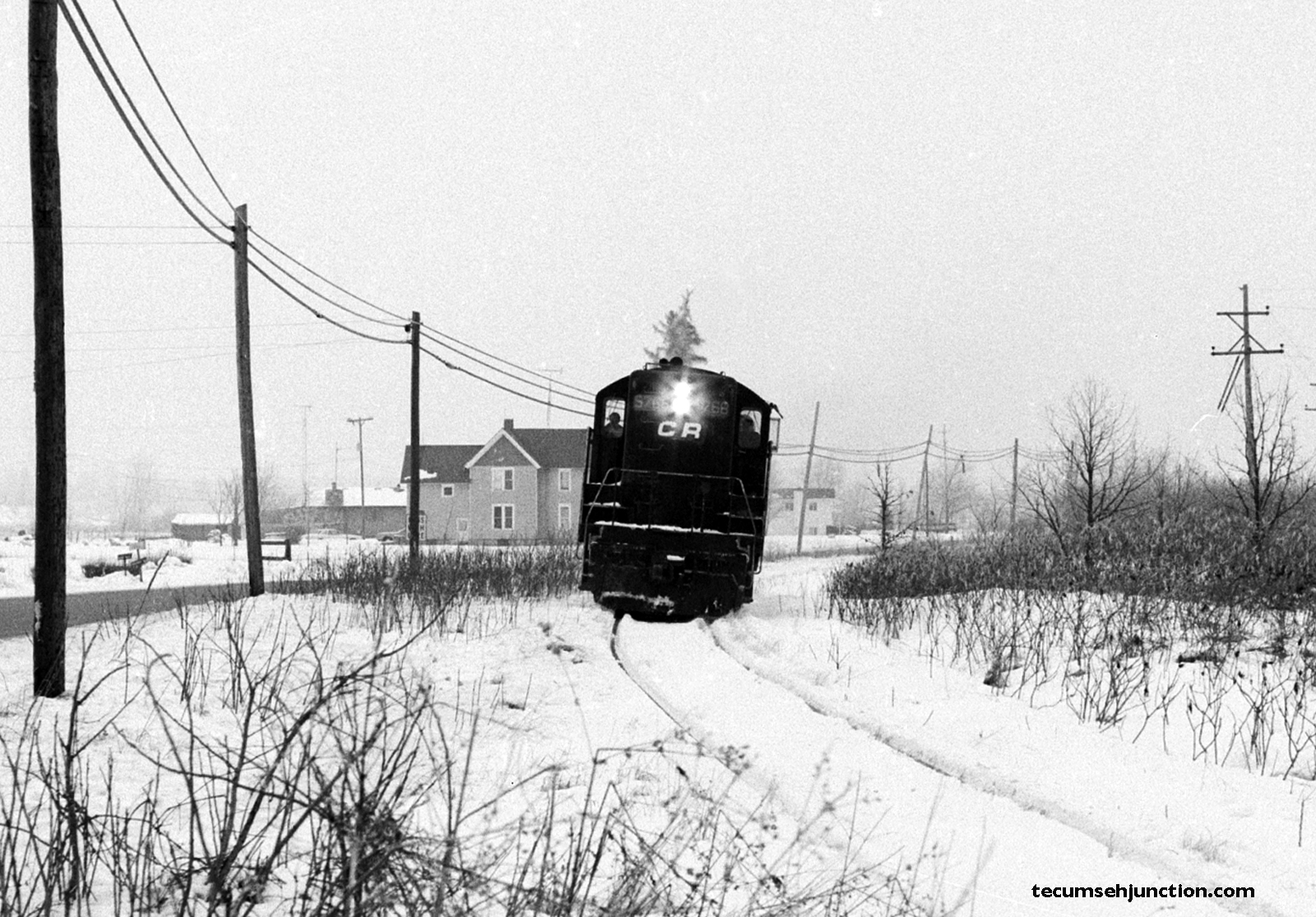
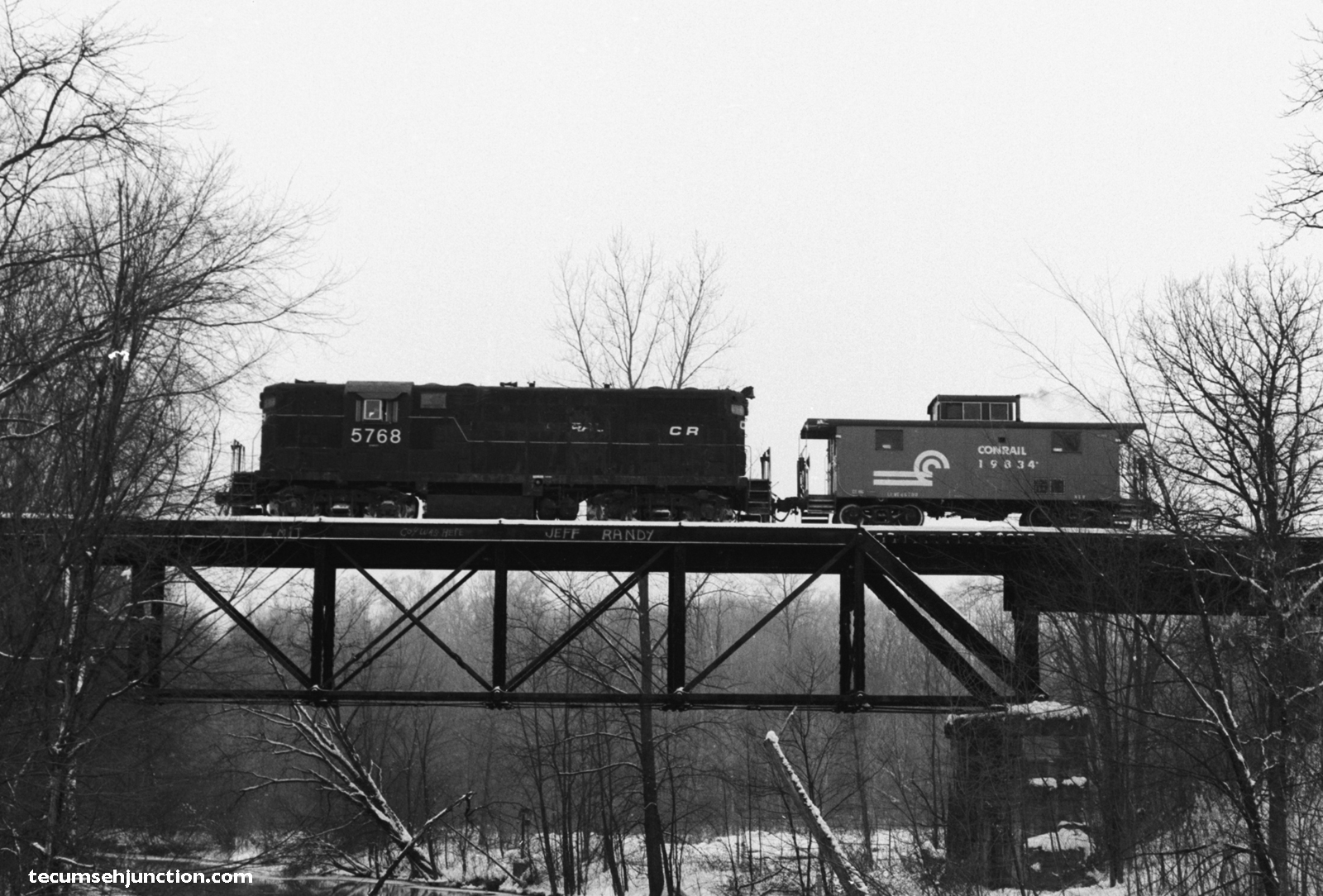
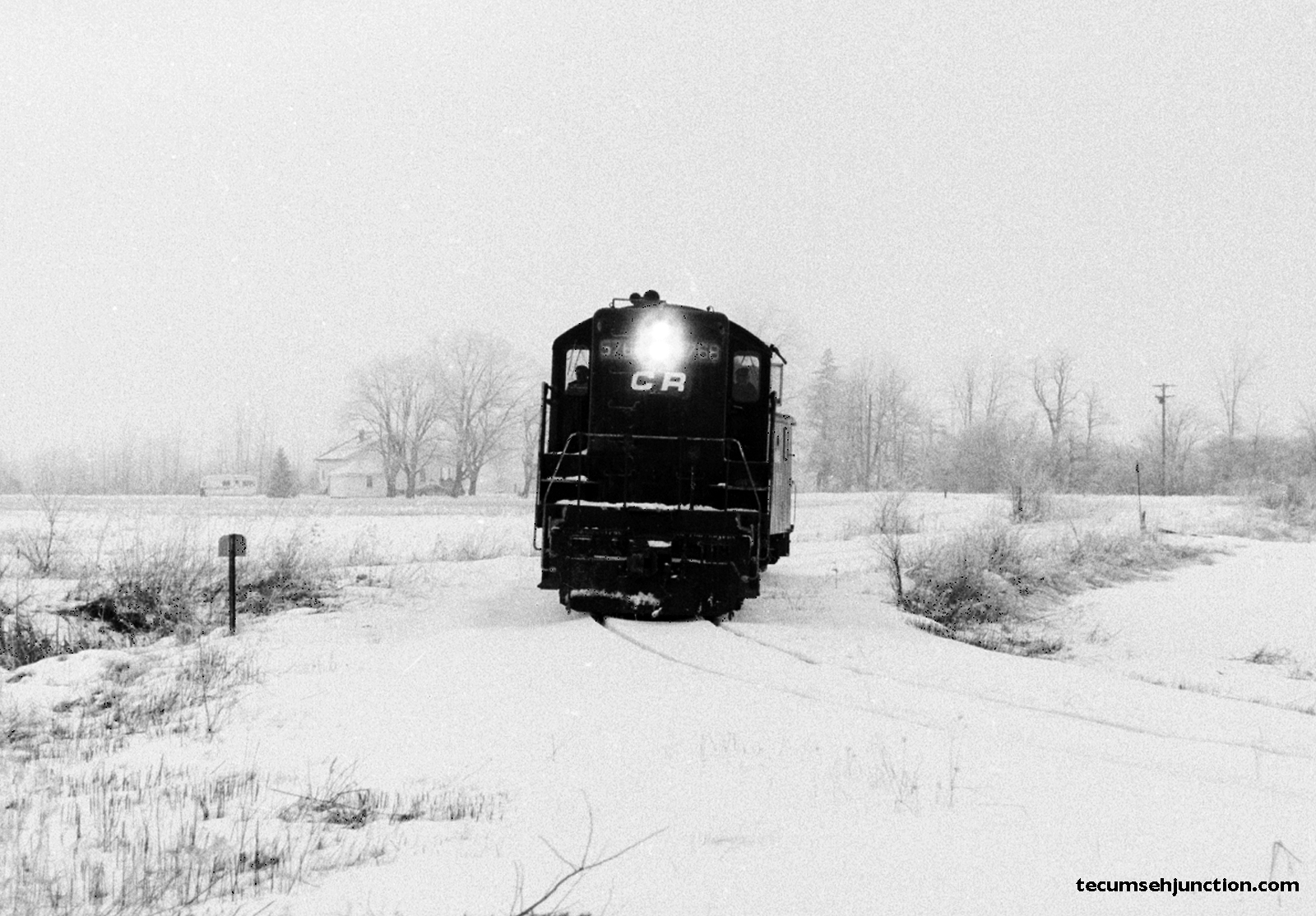
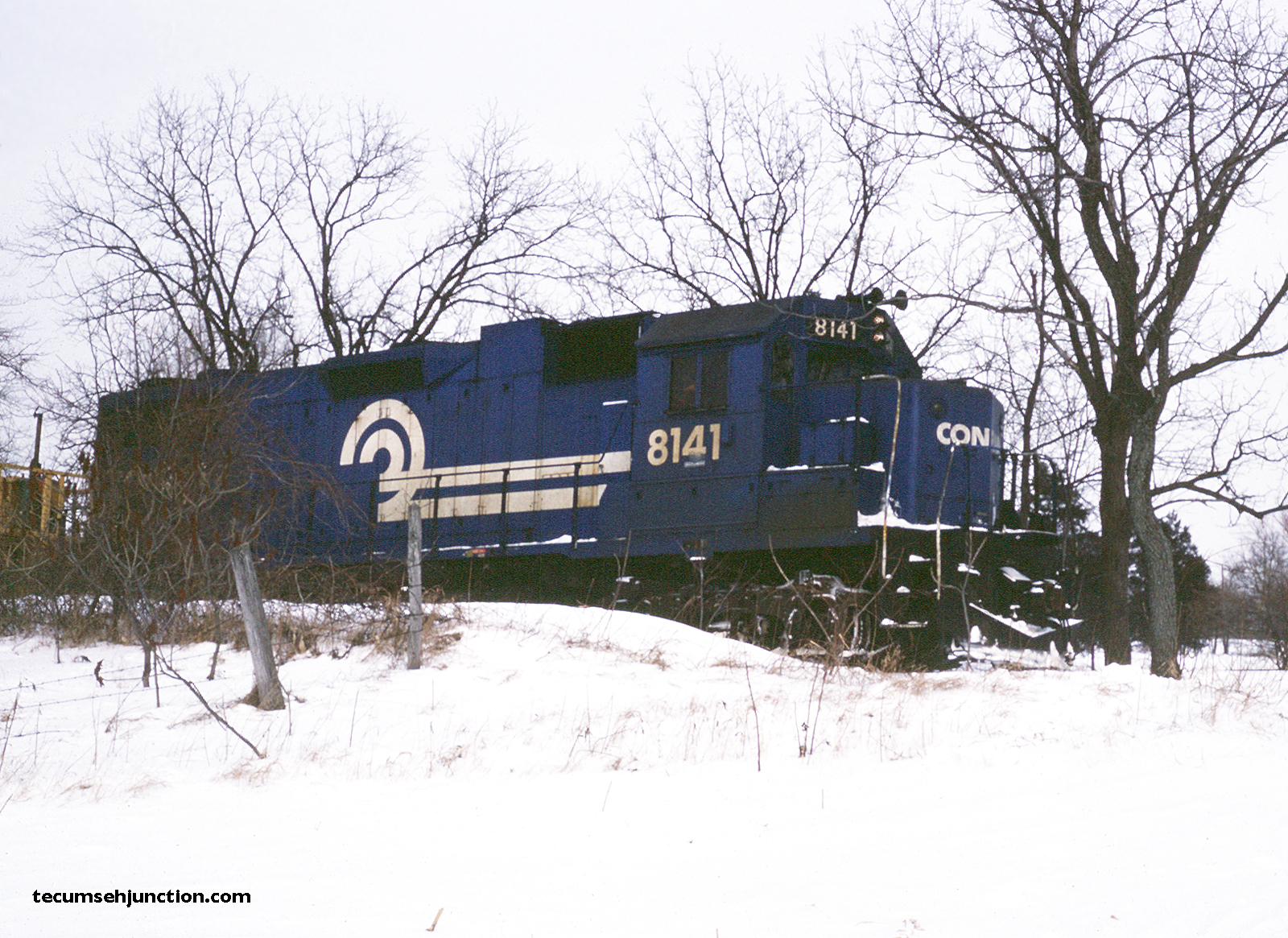
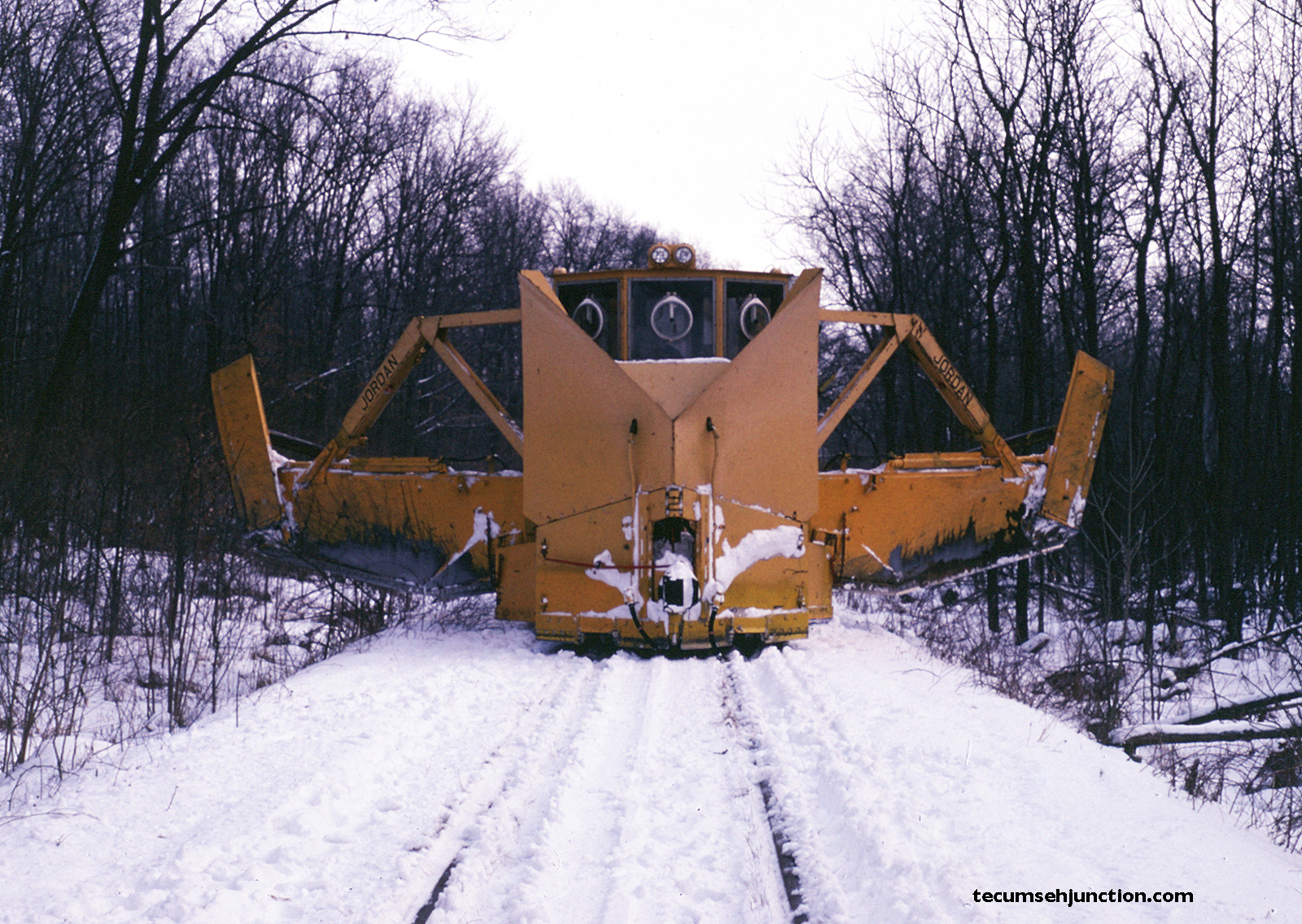
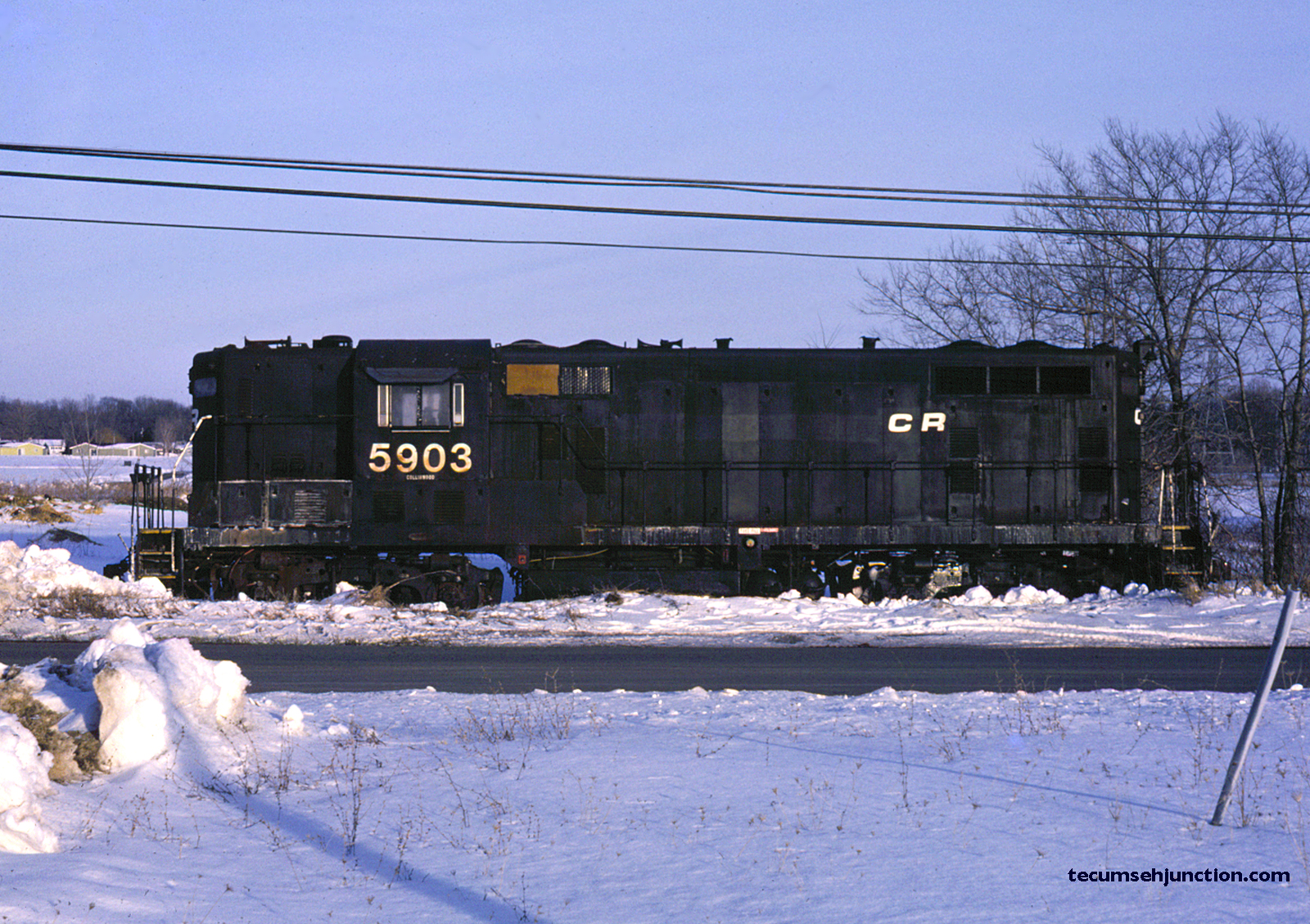
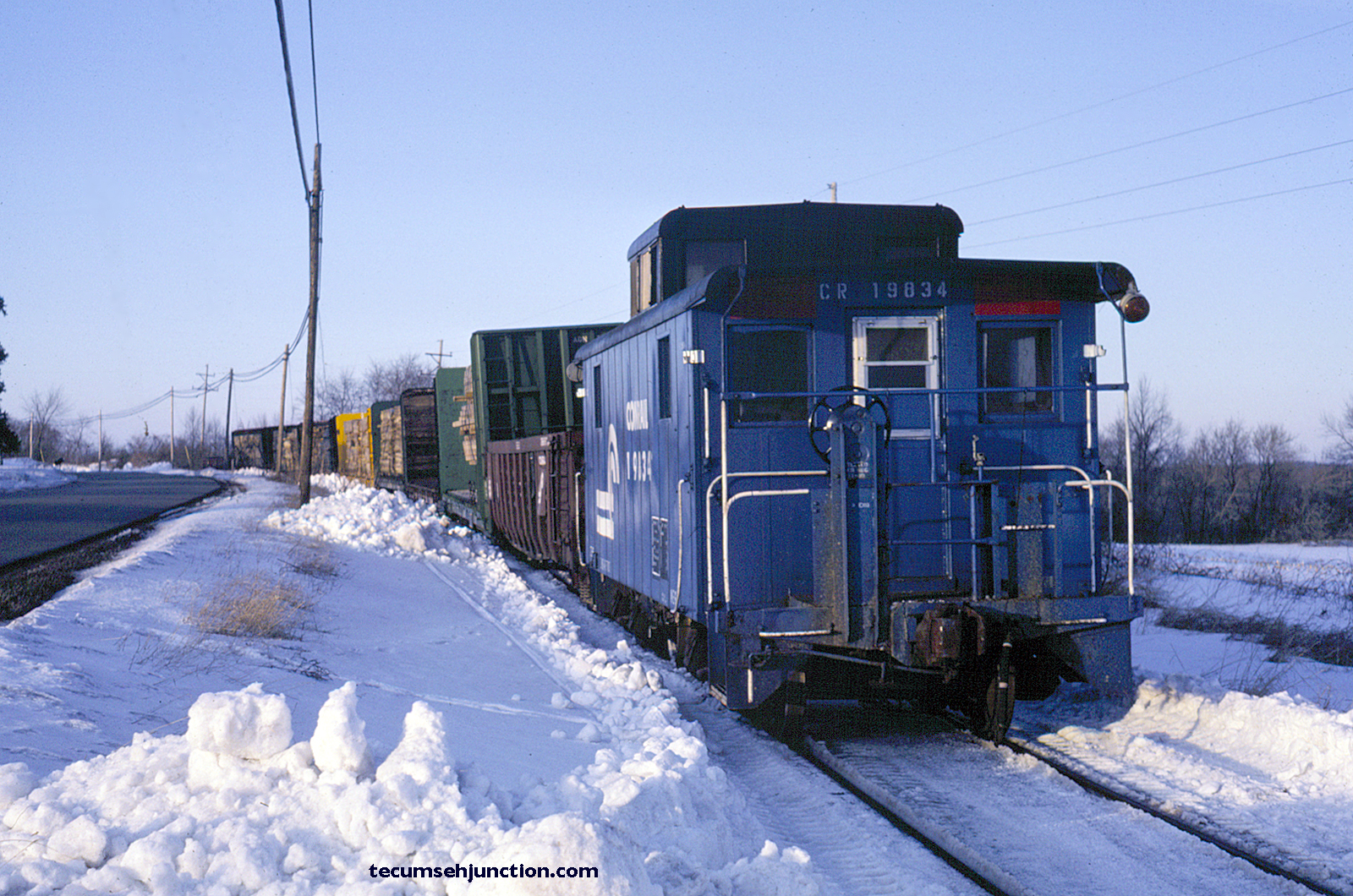
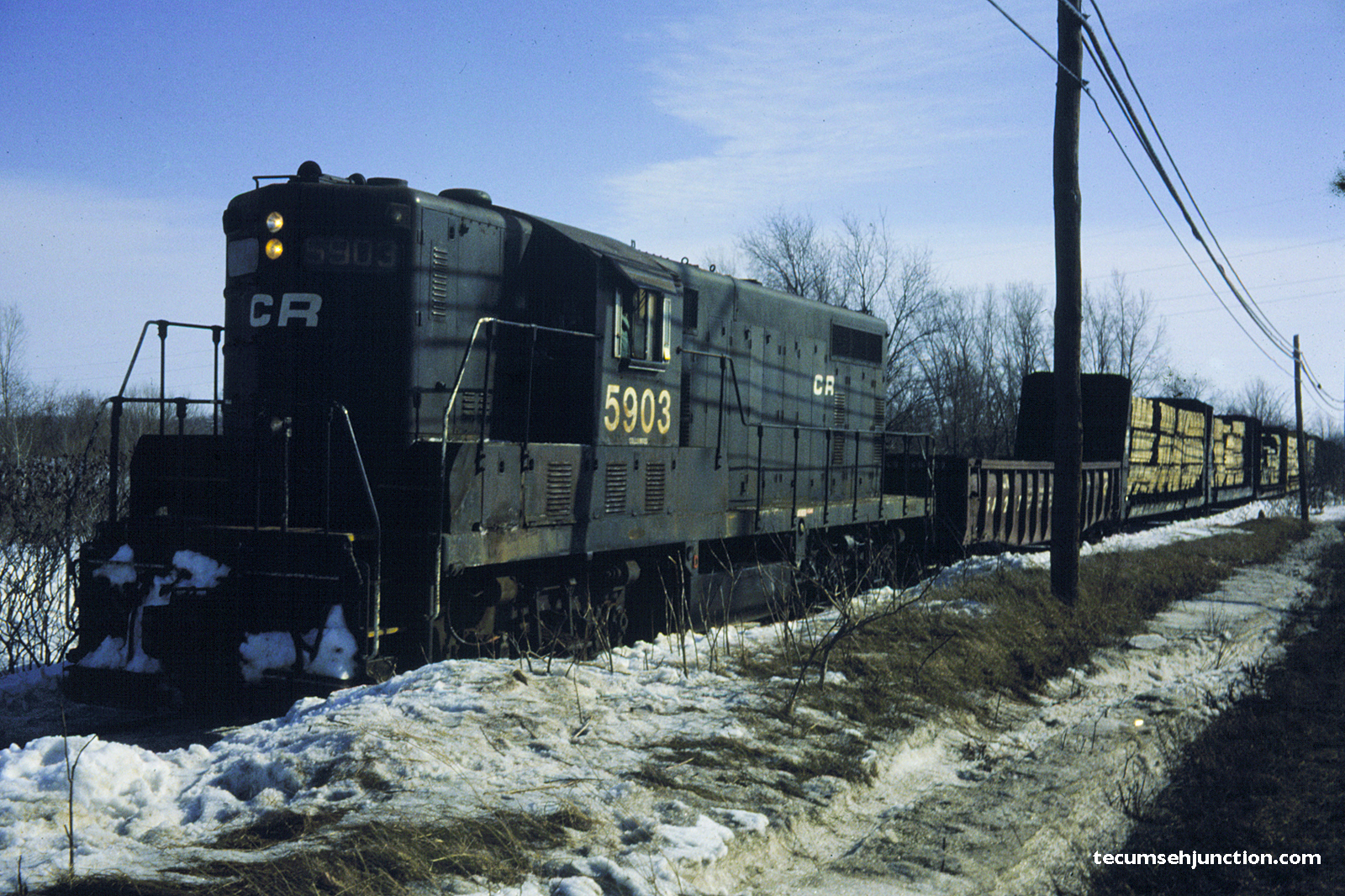
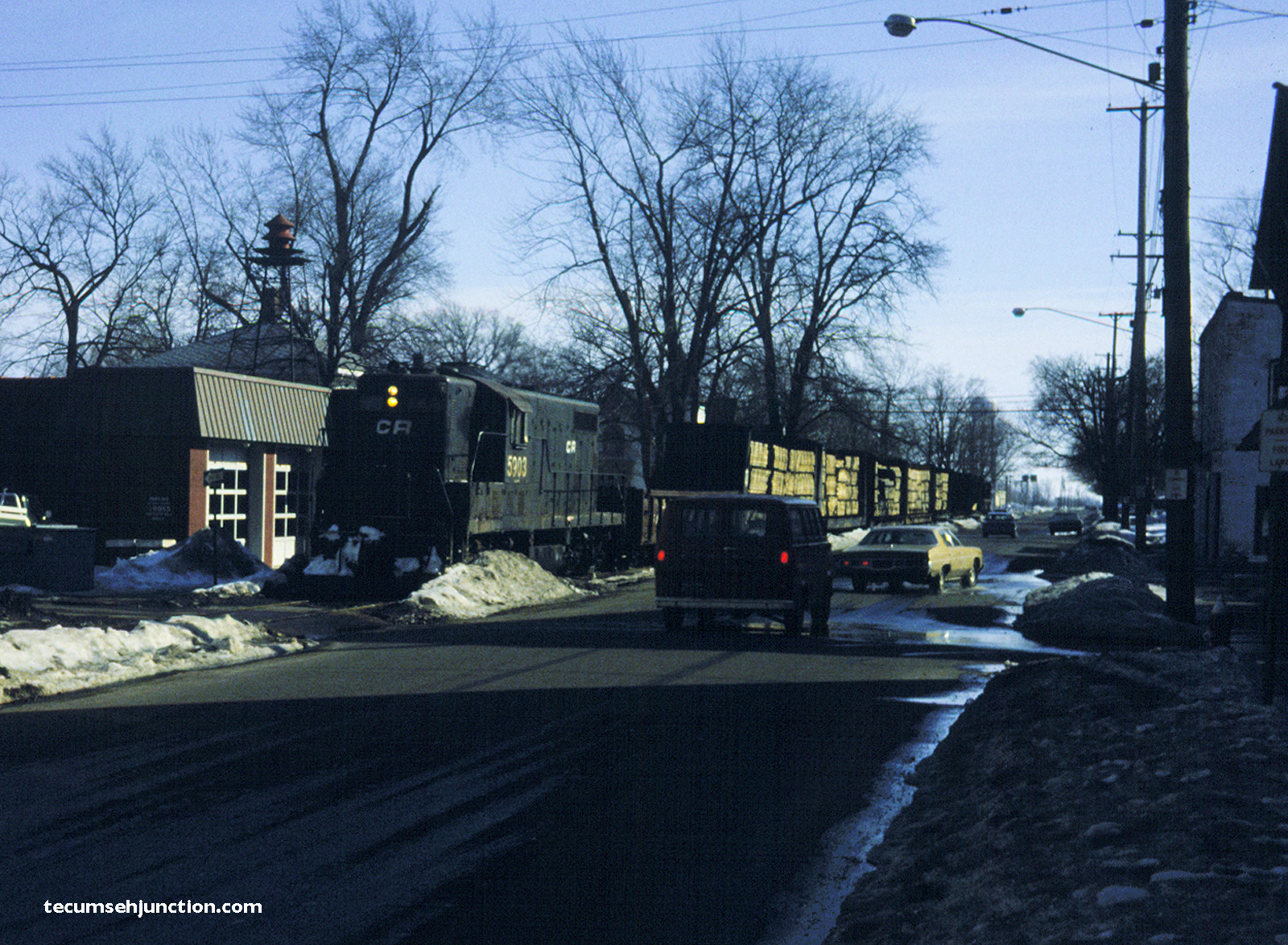
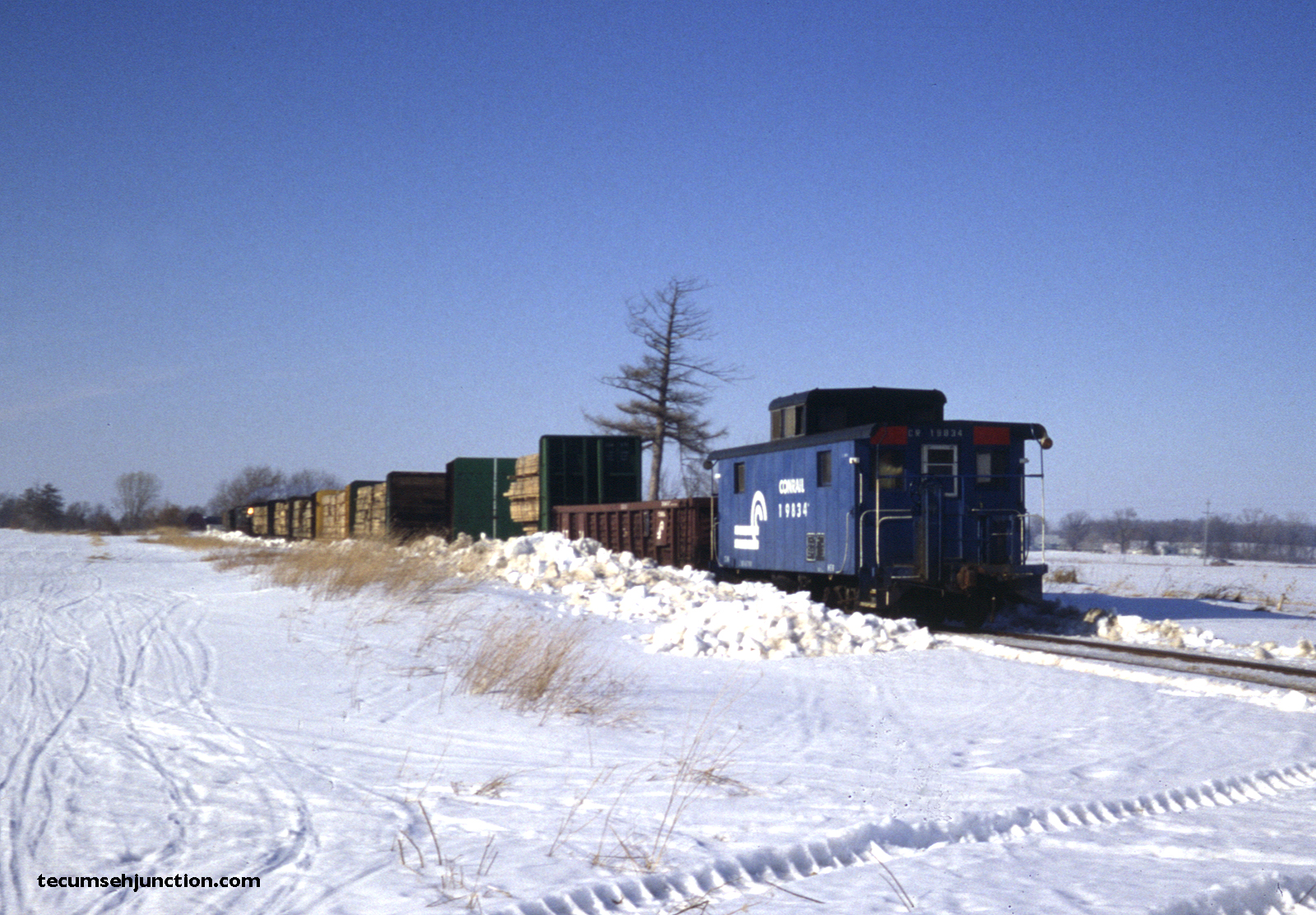
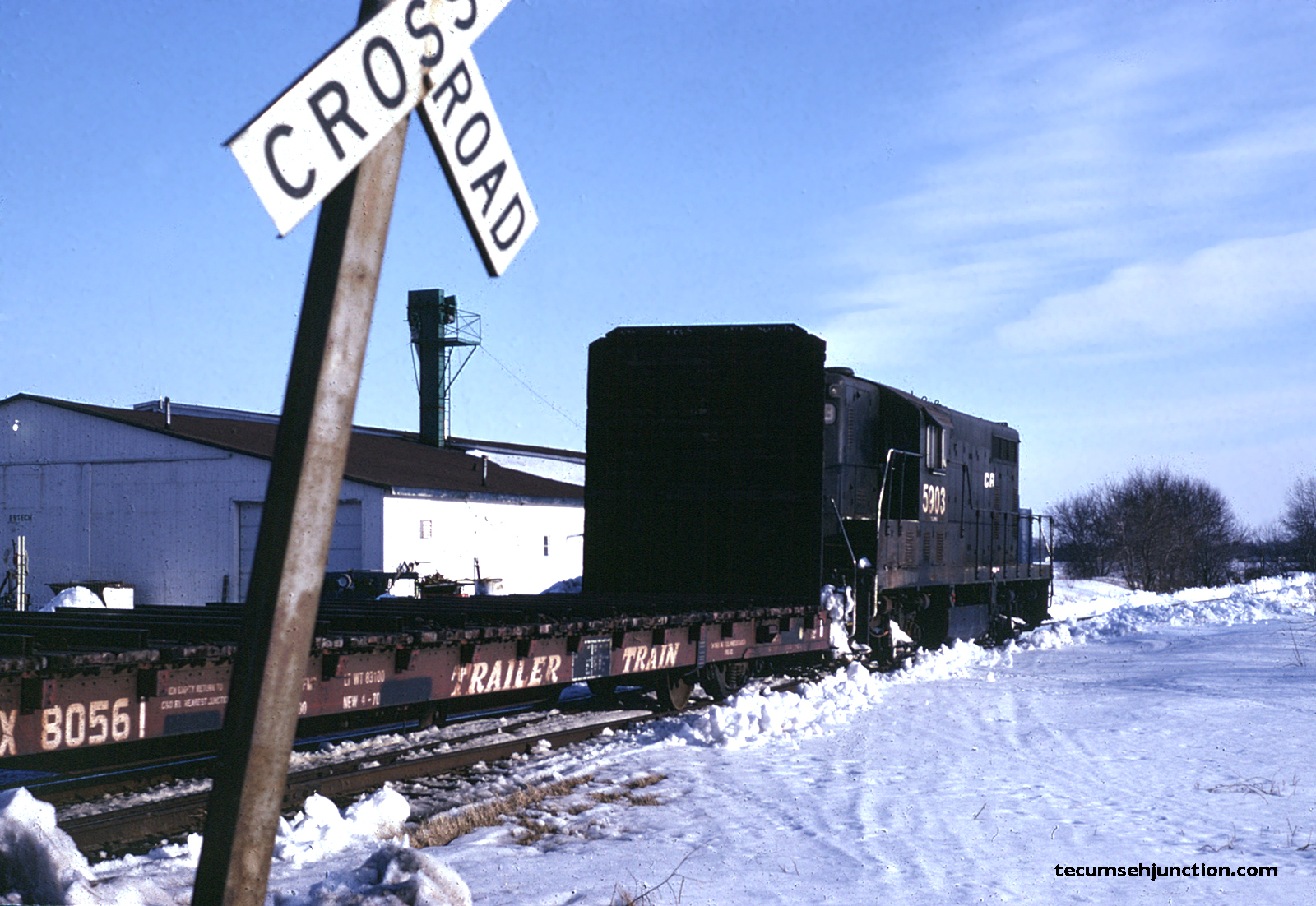
Leave a Reply